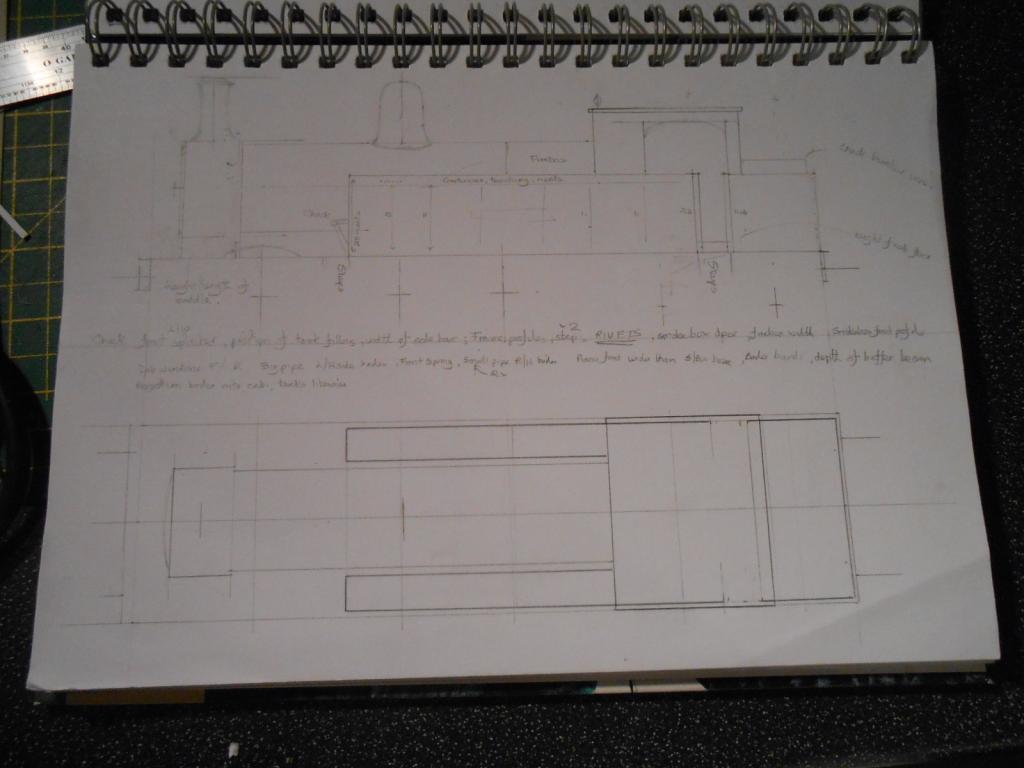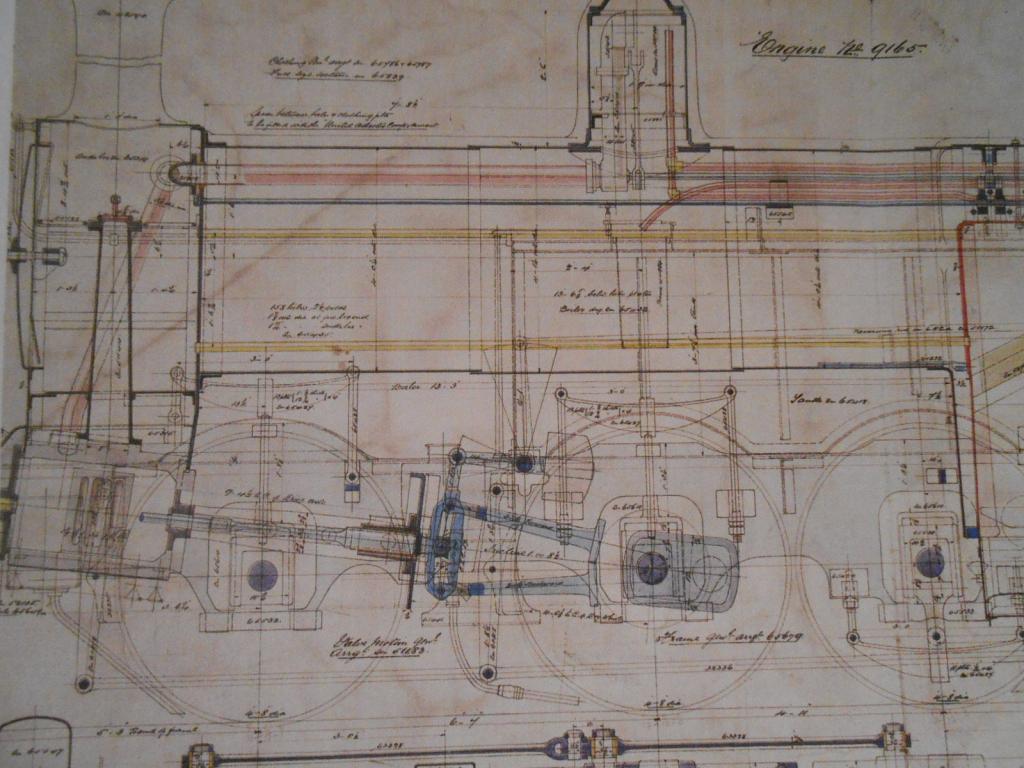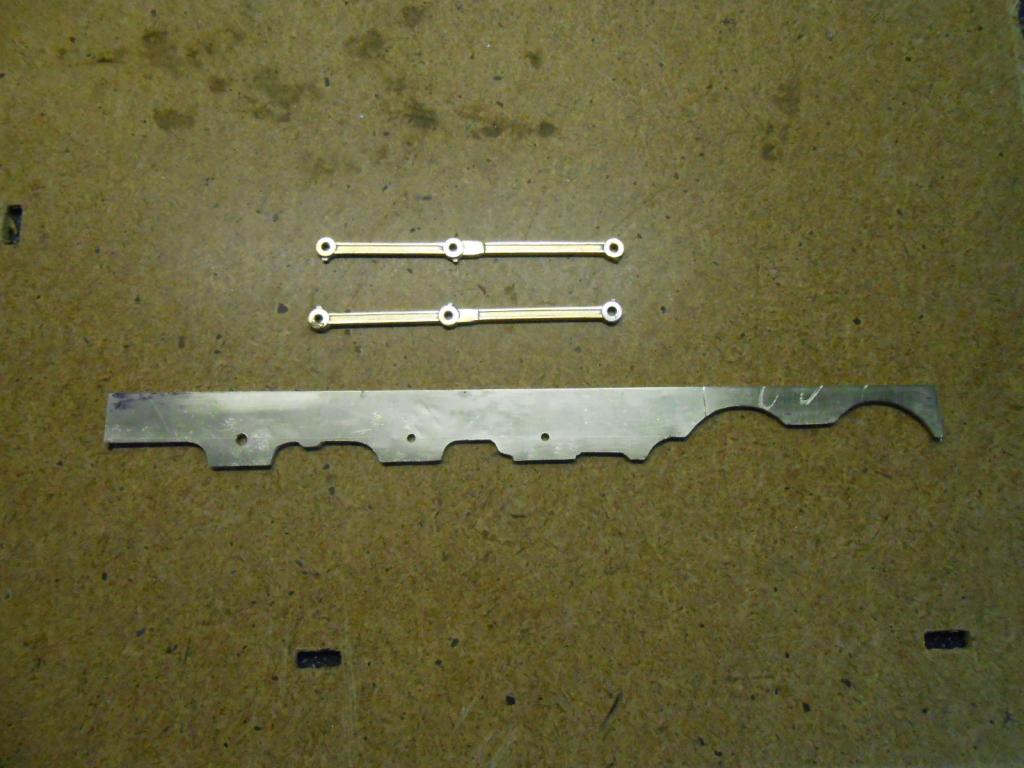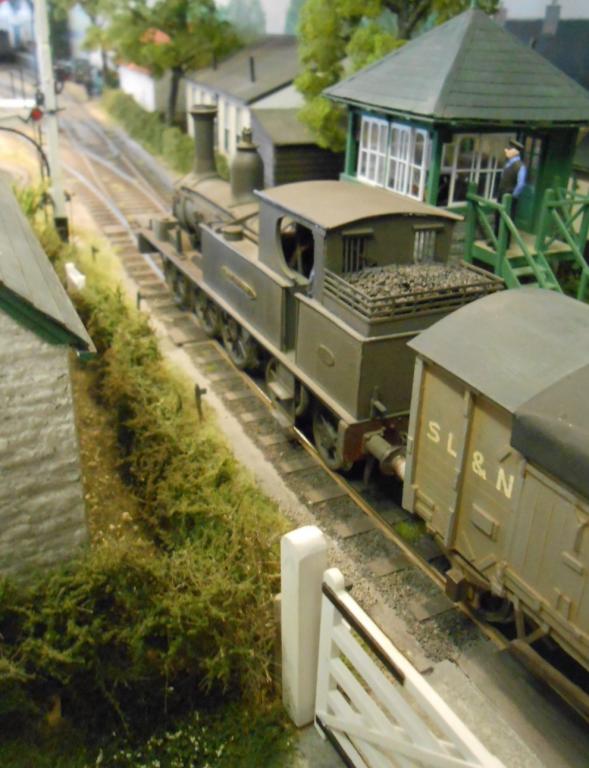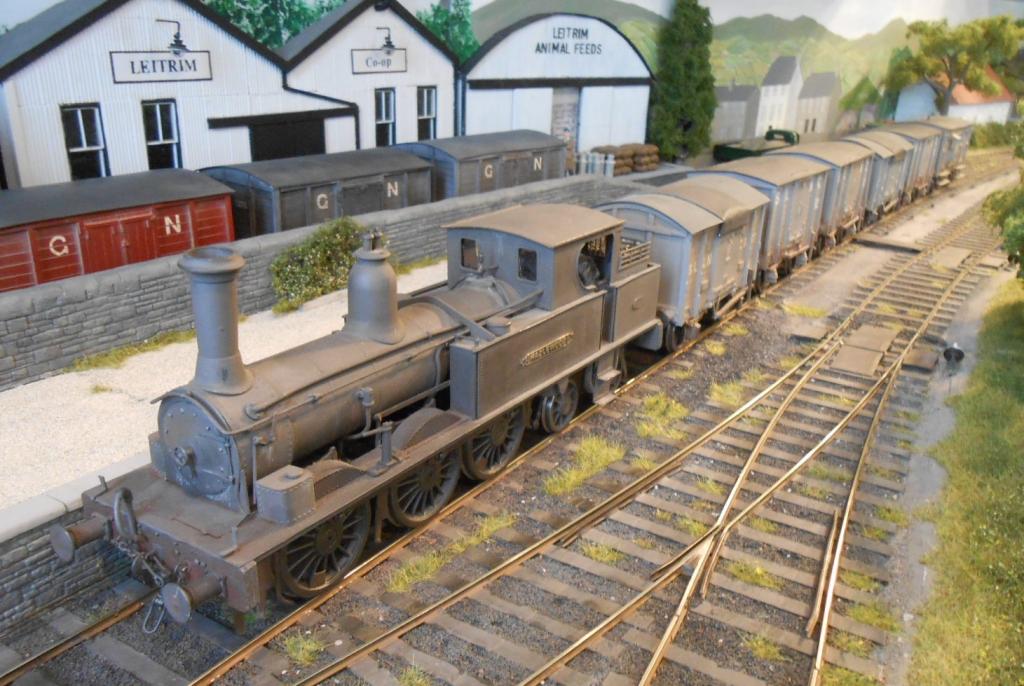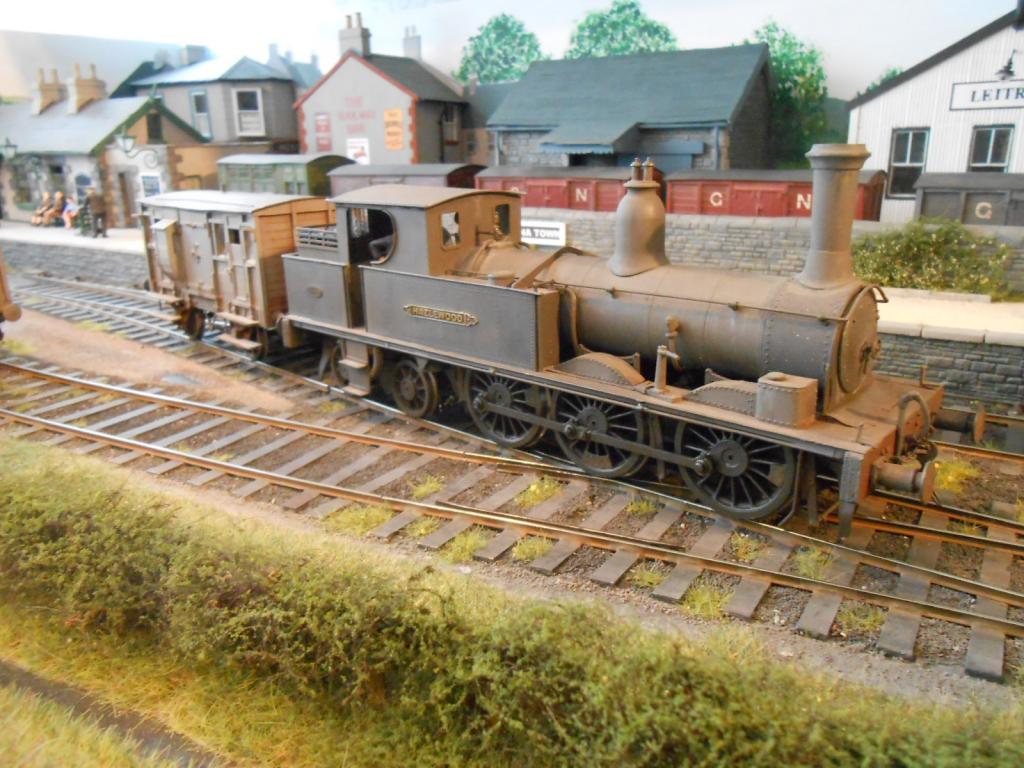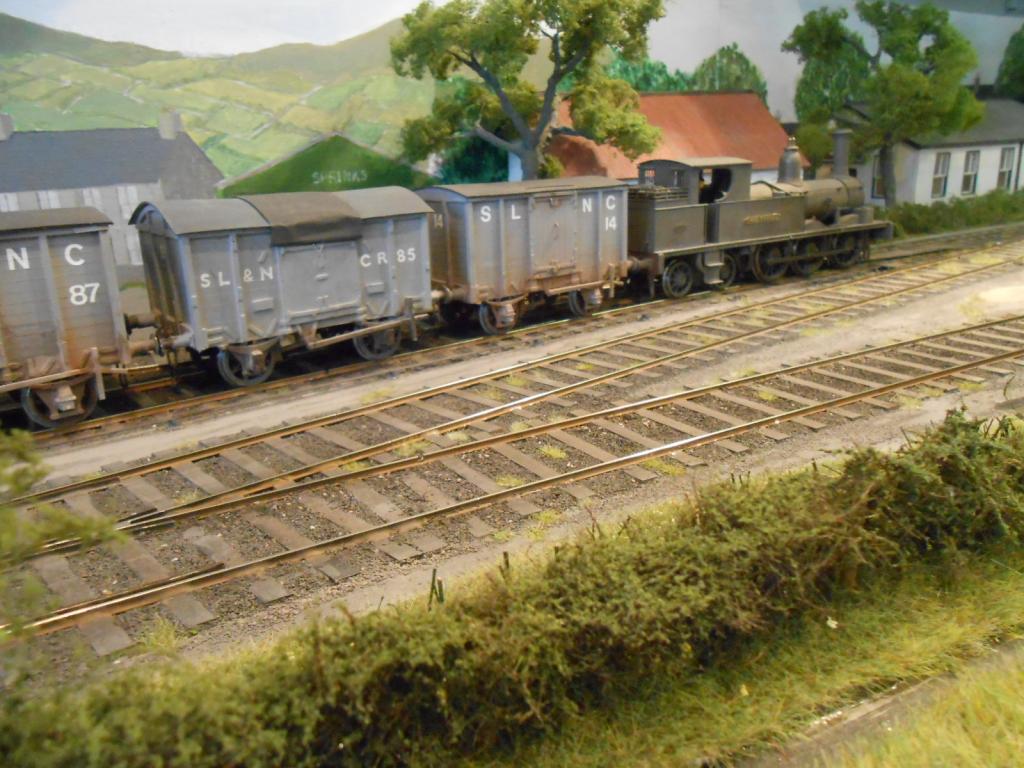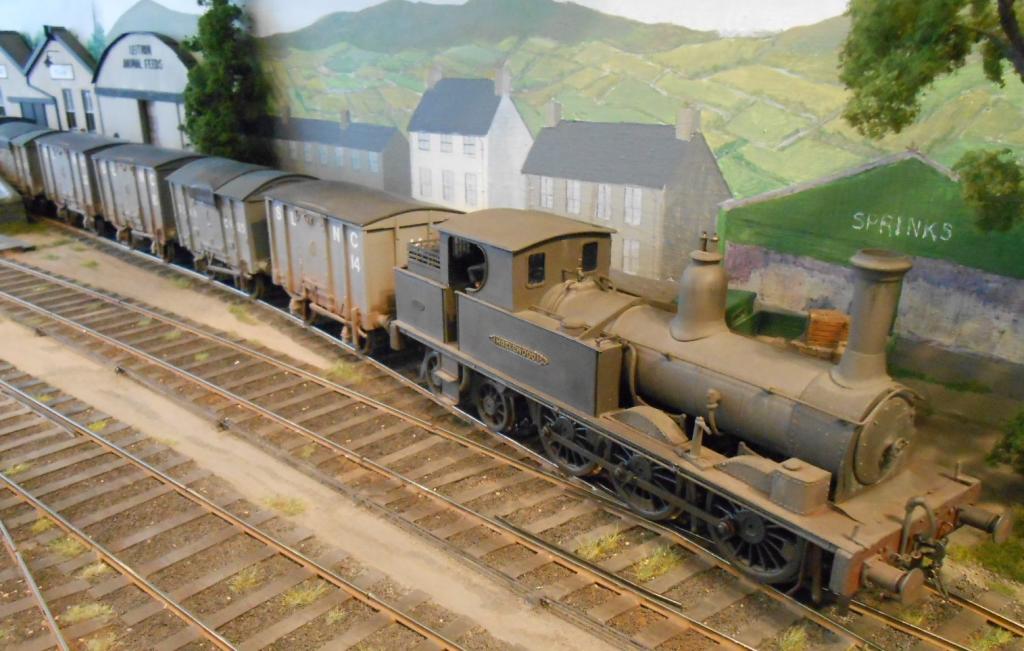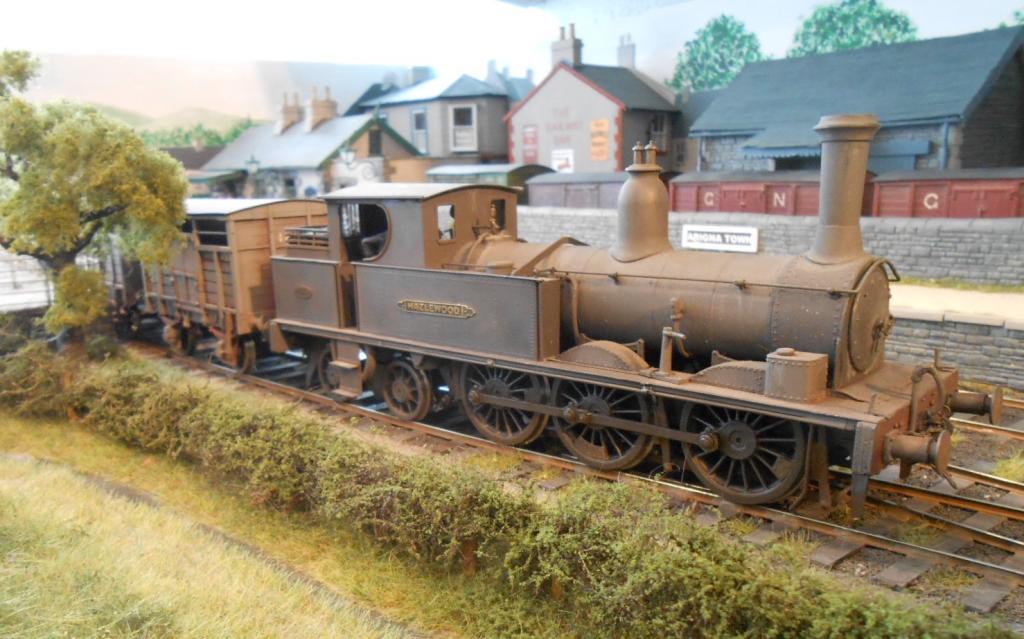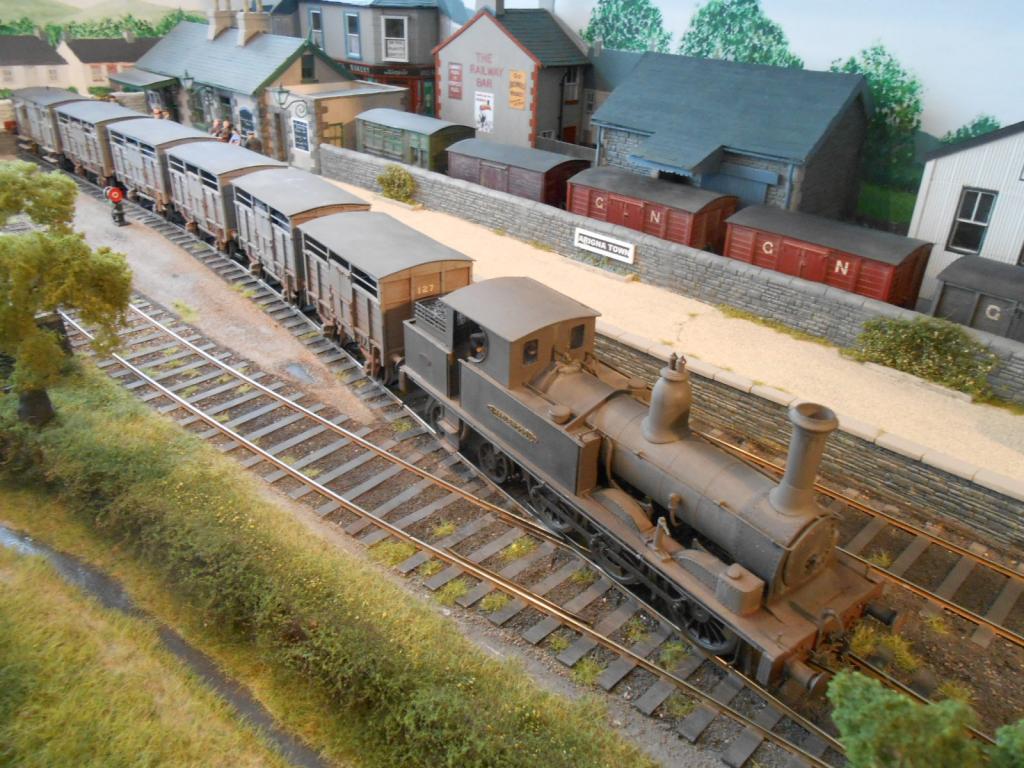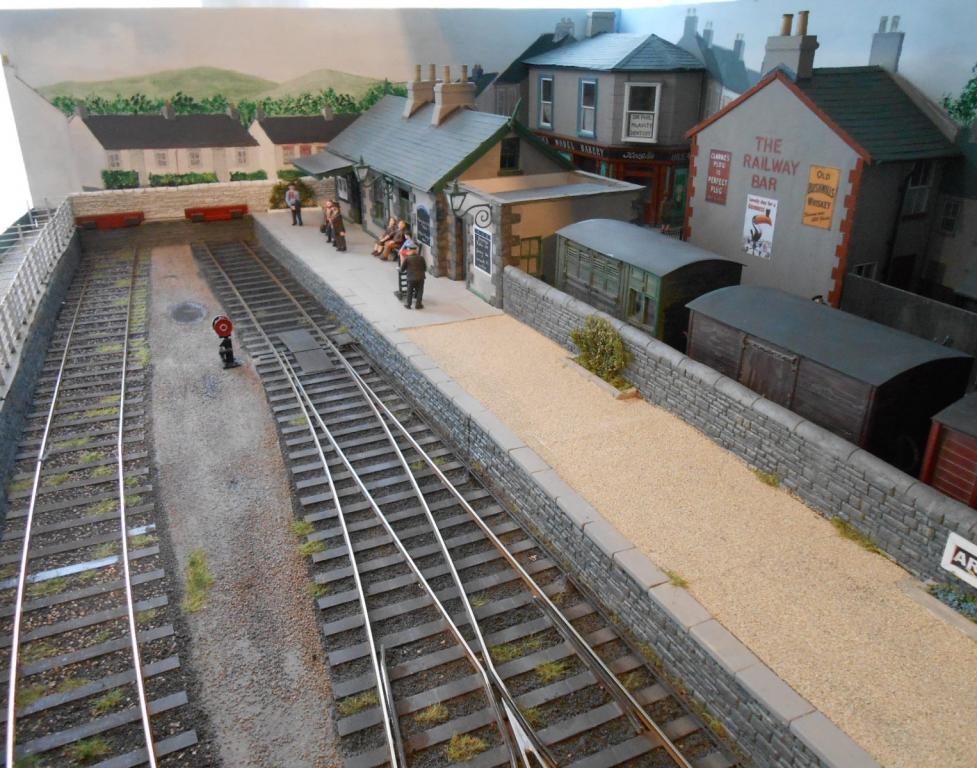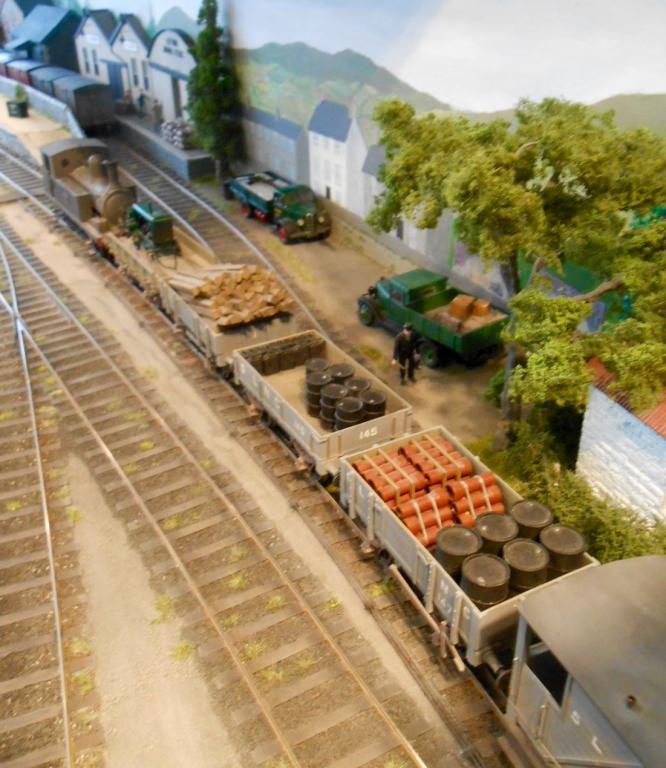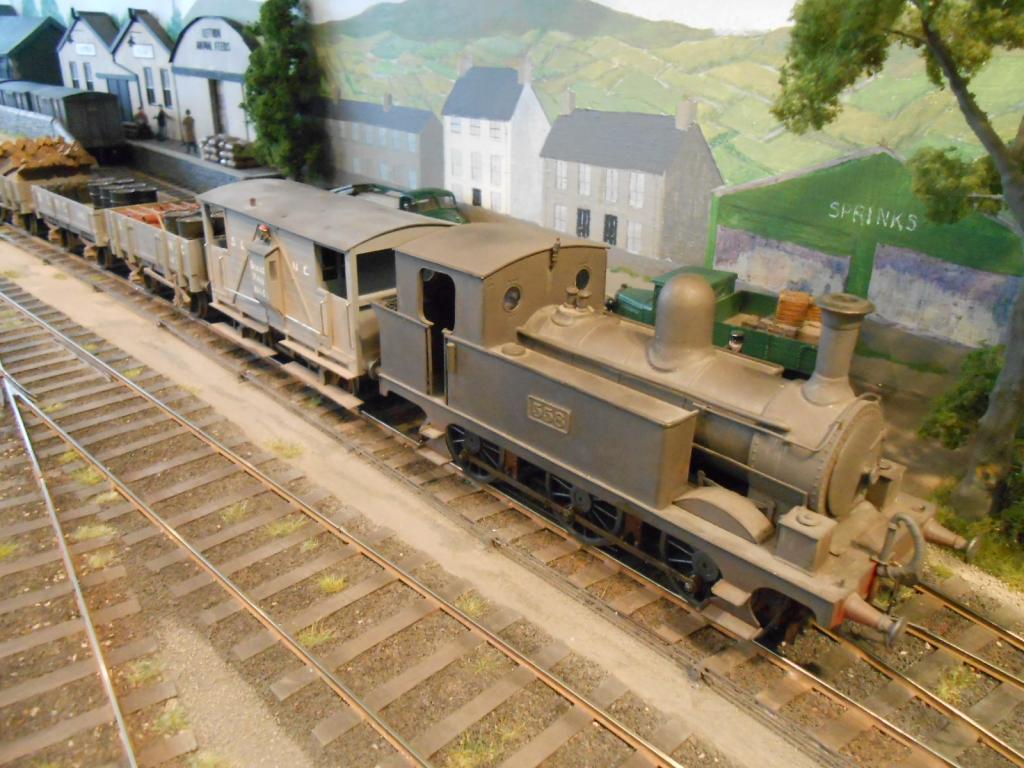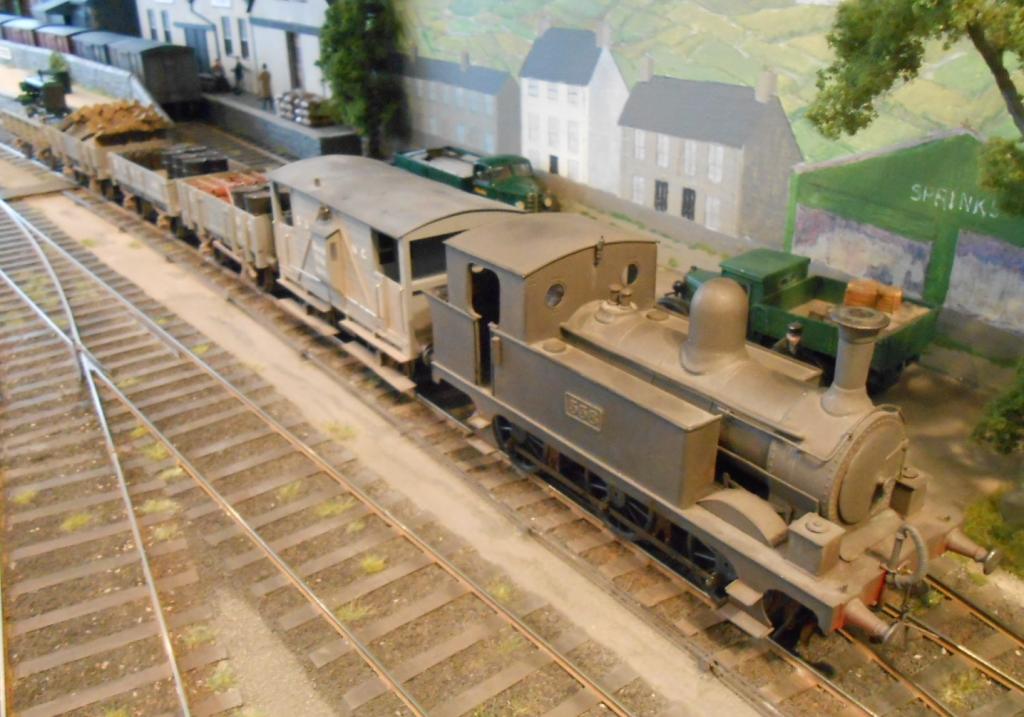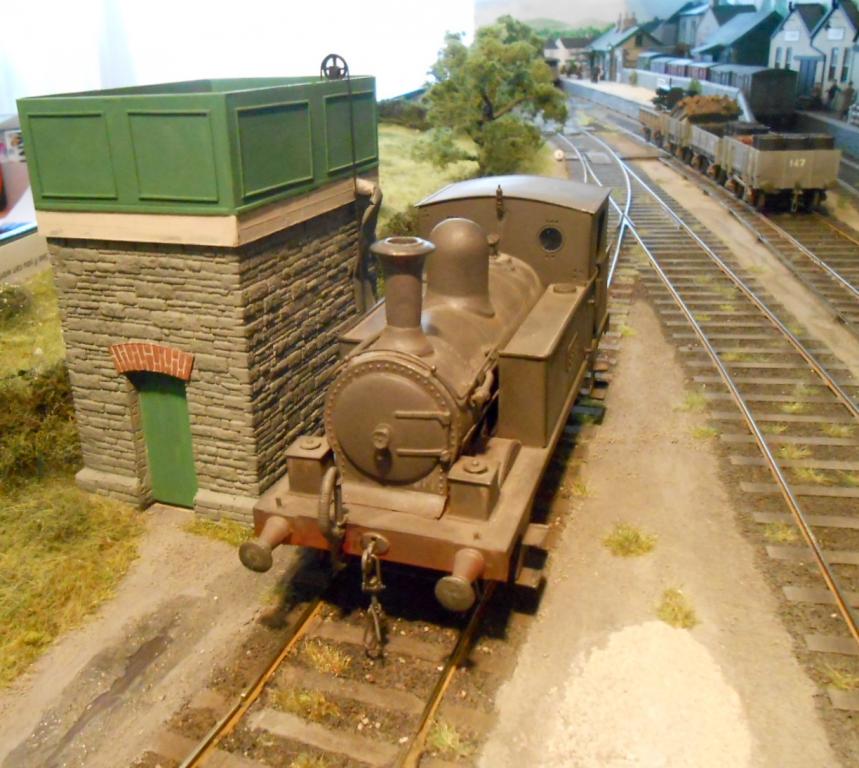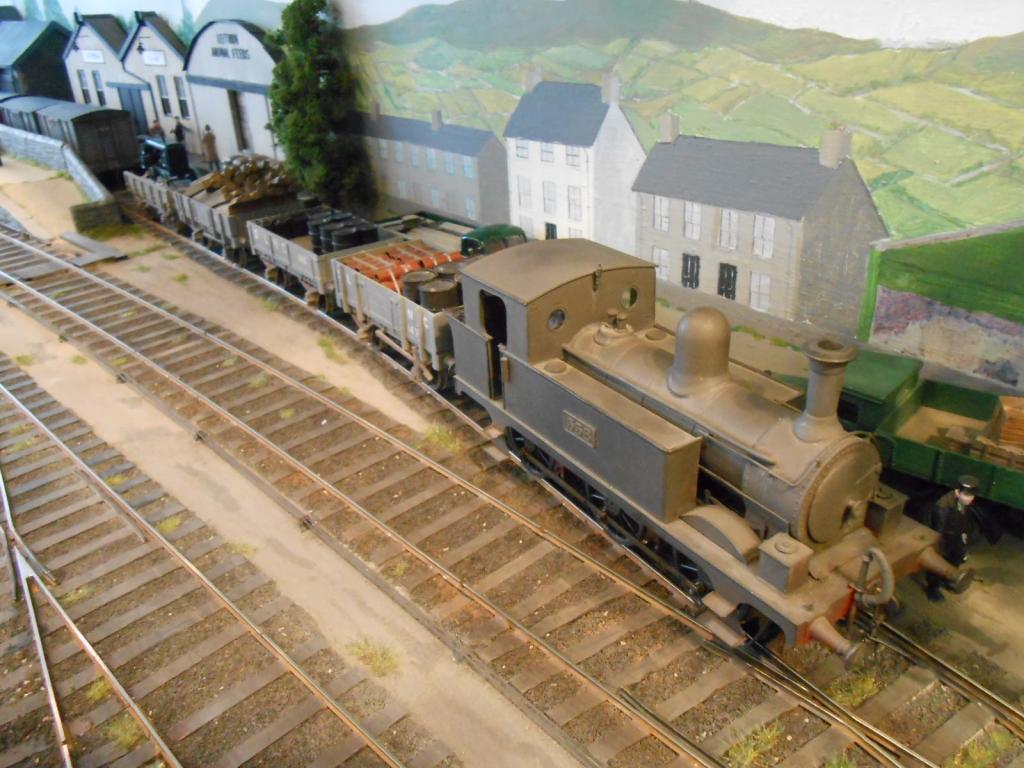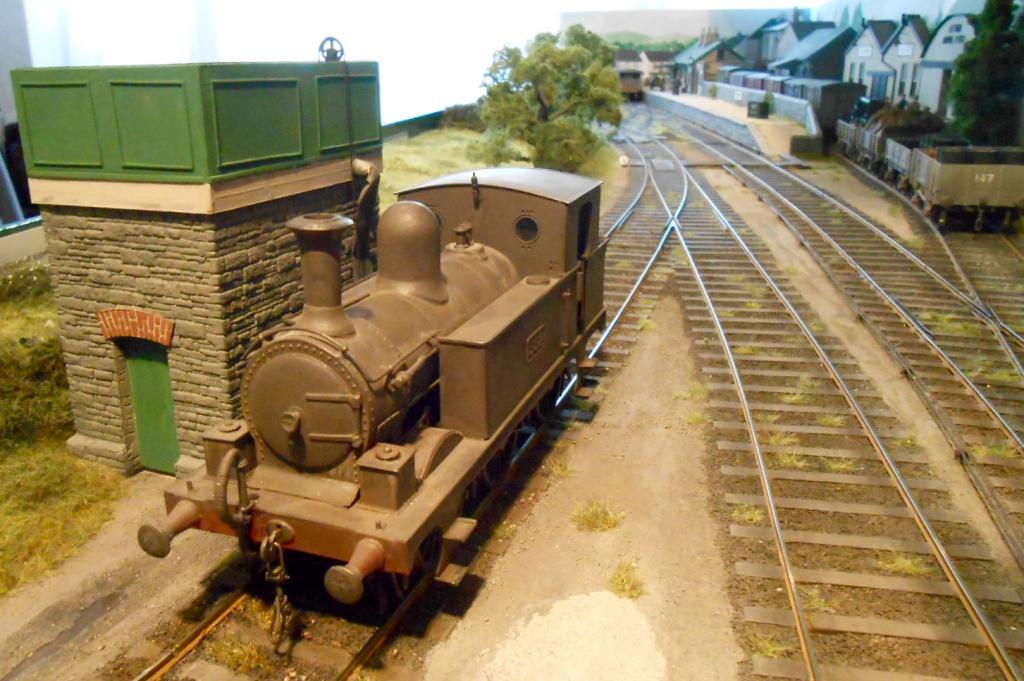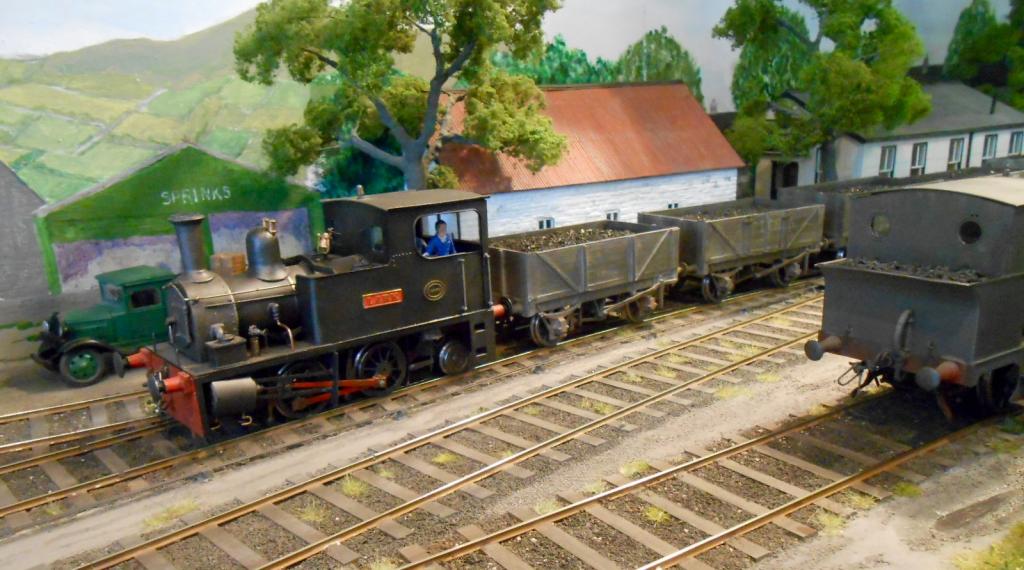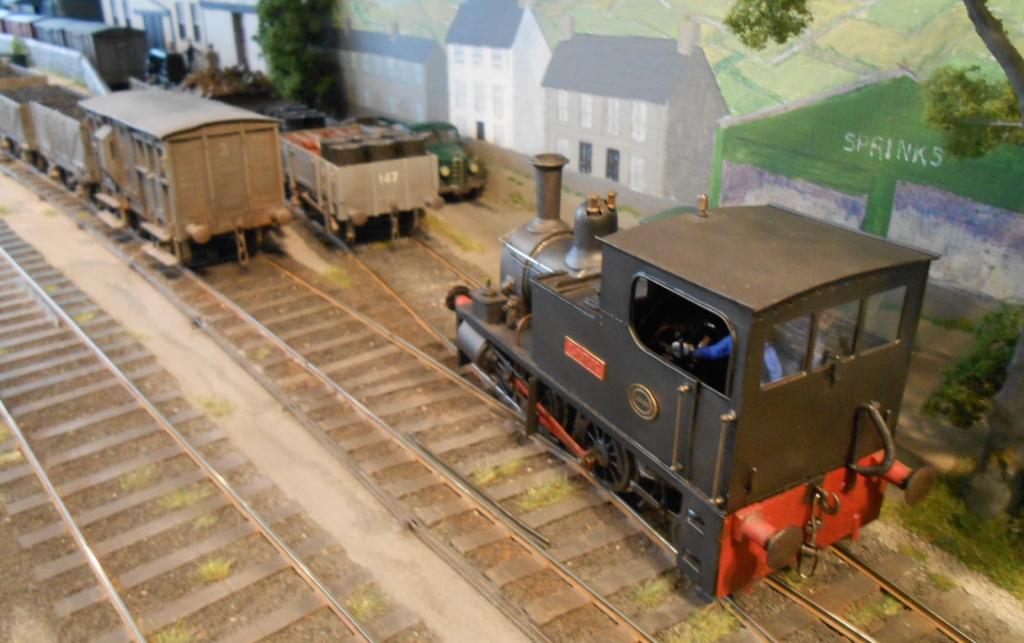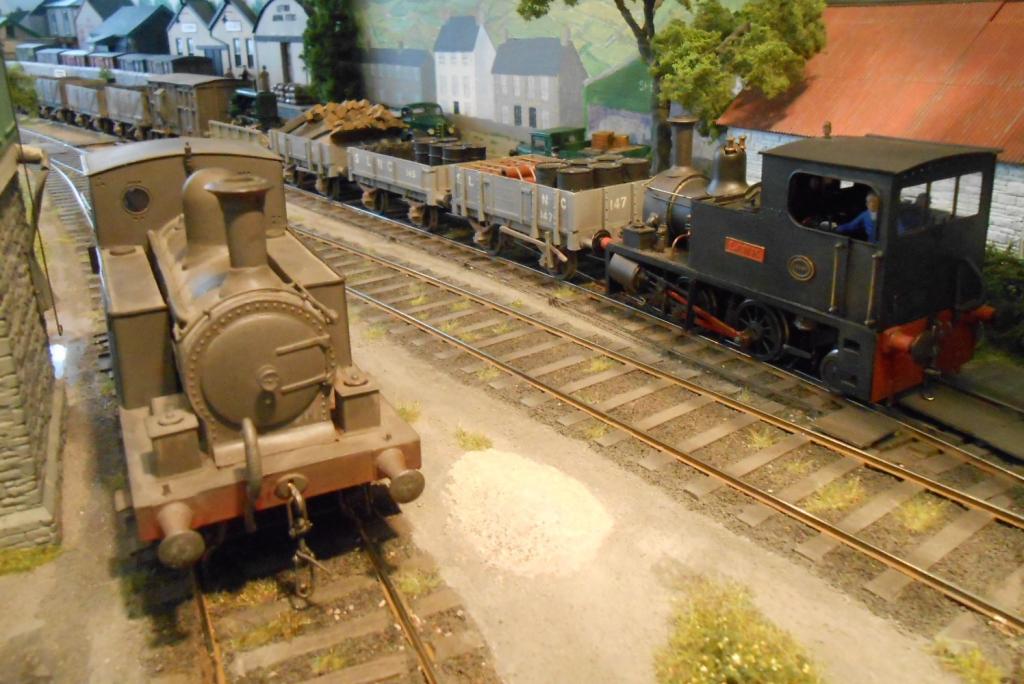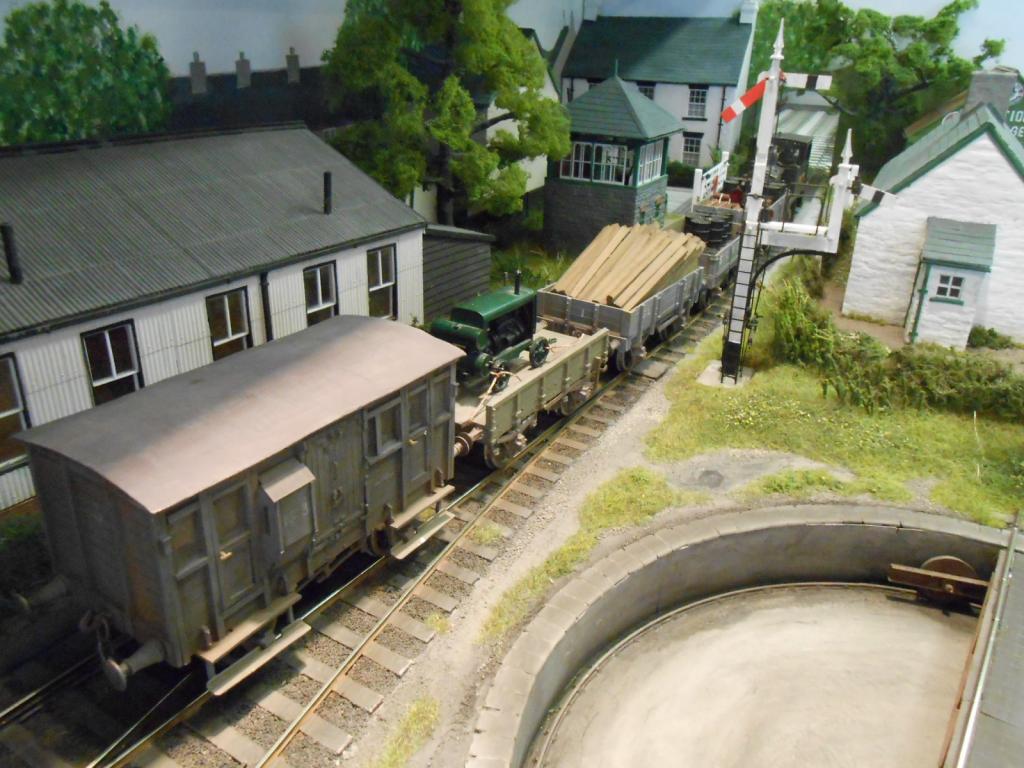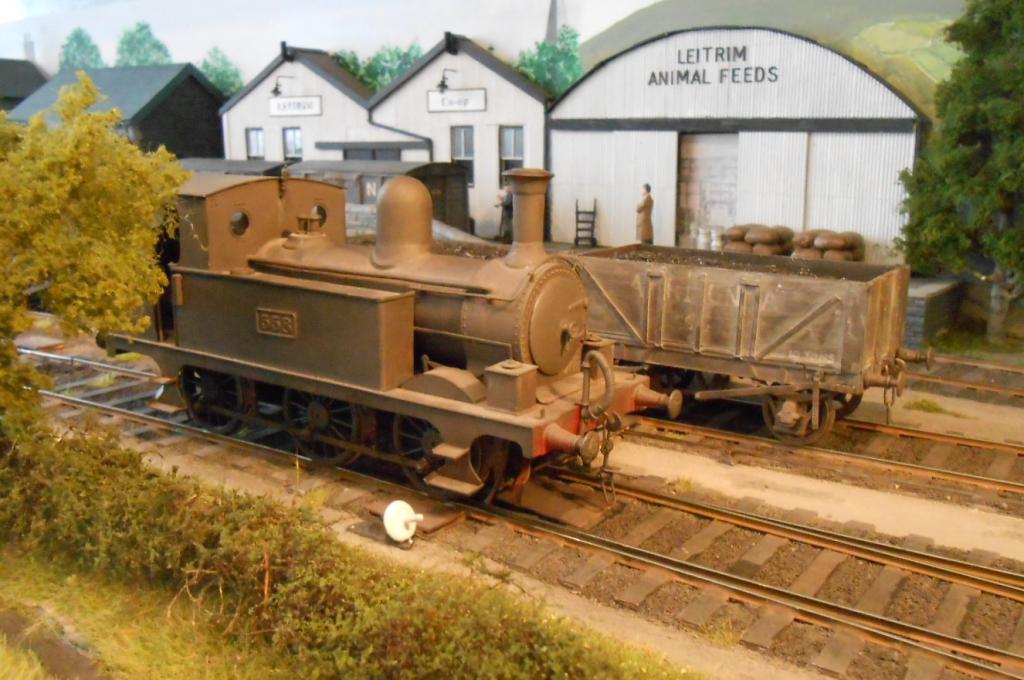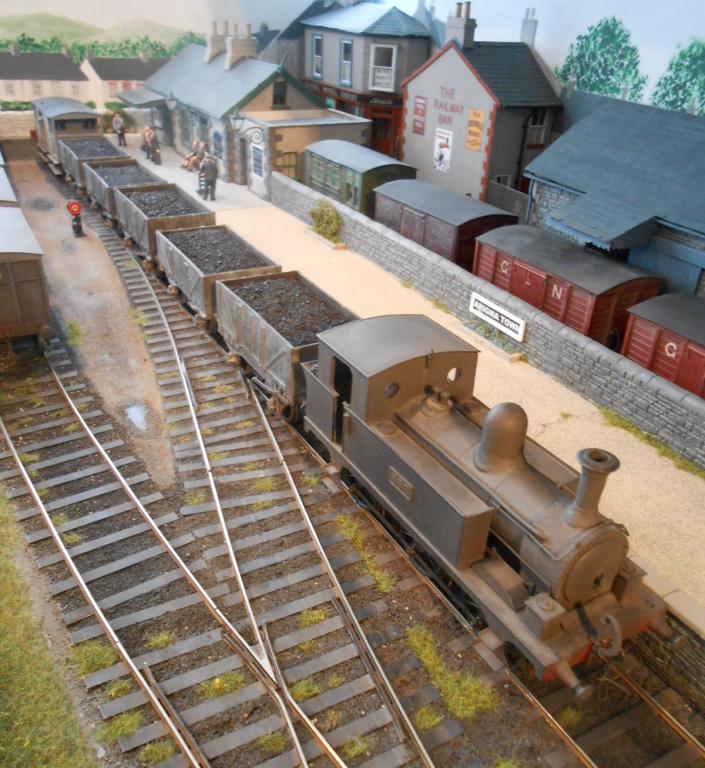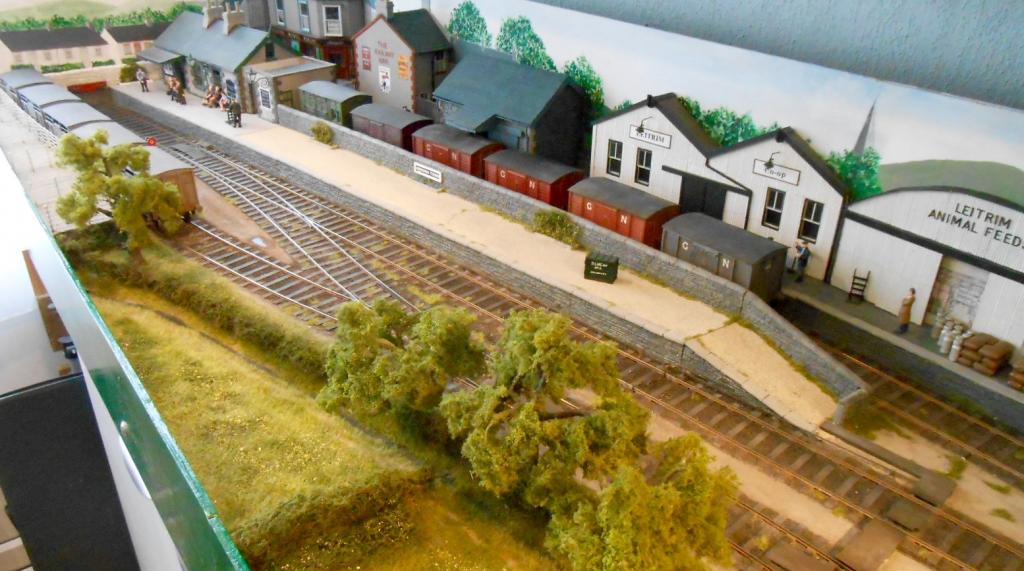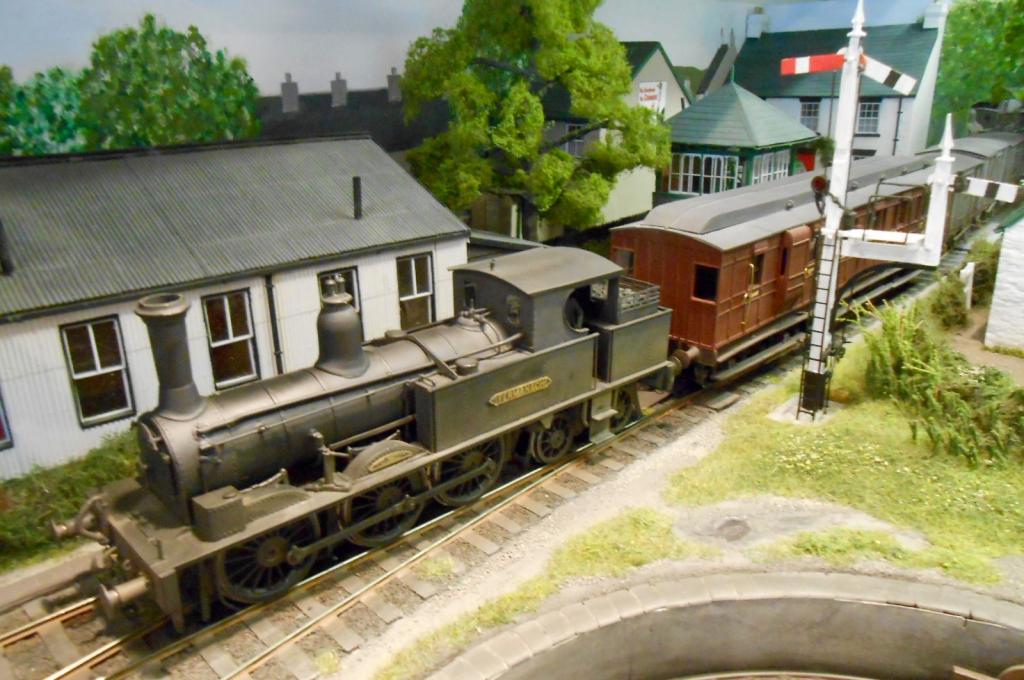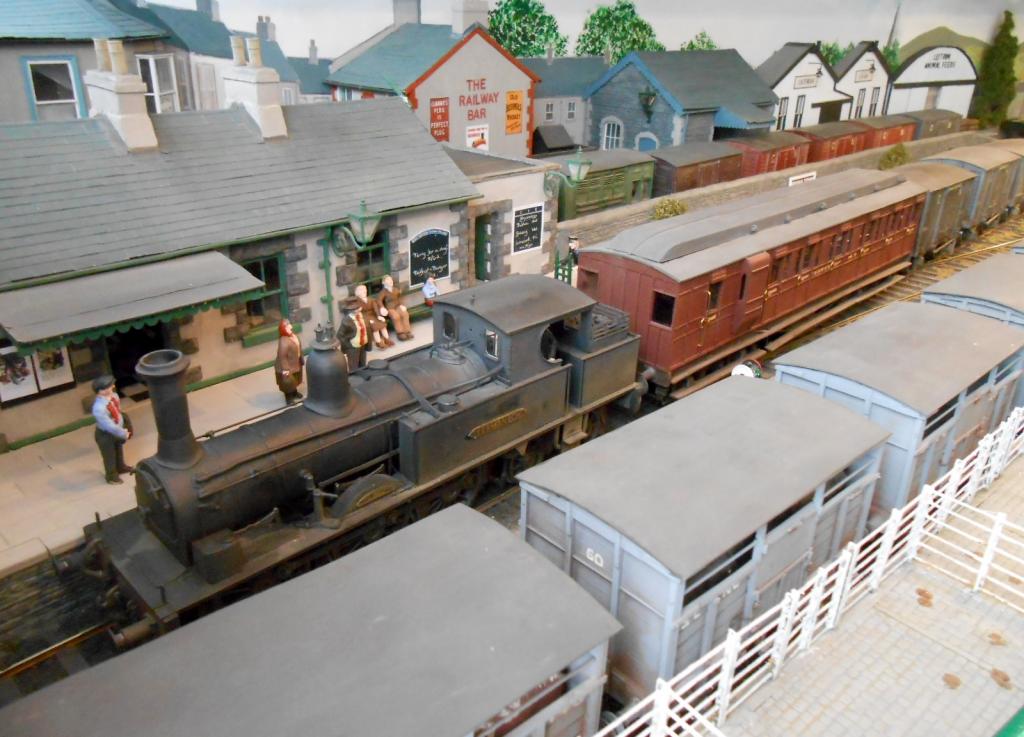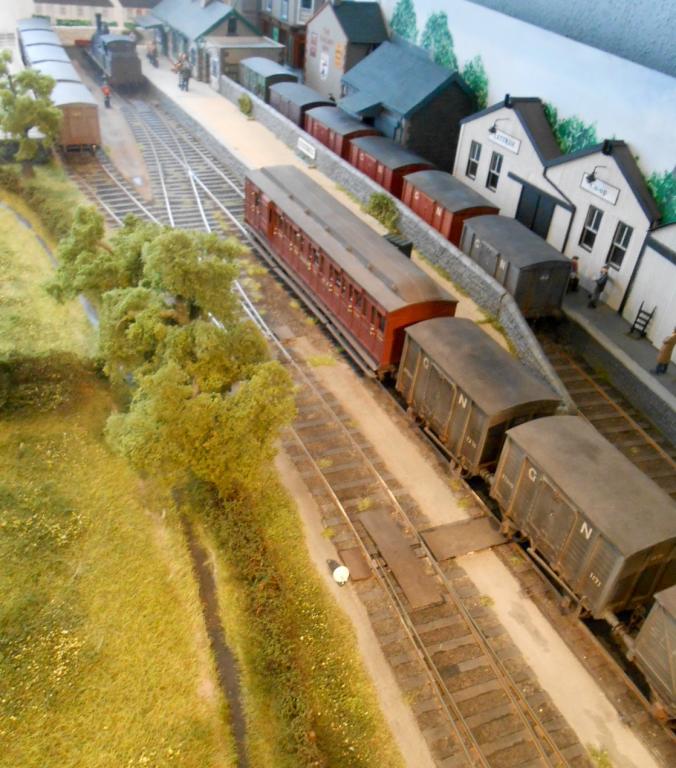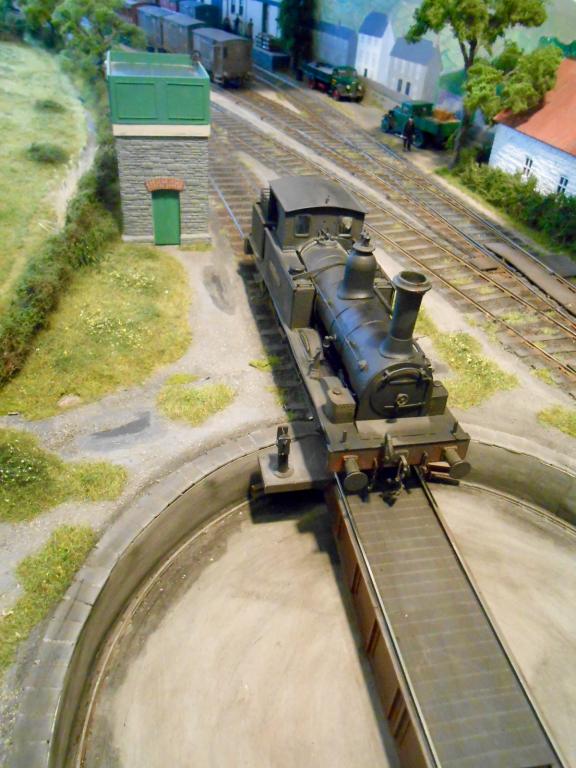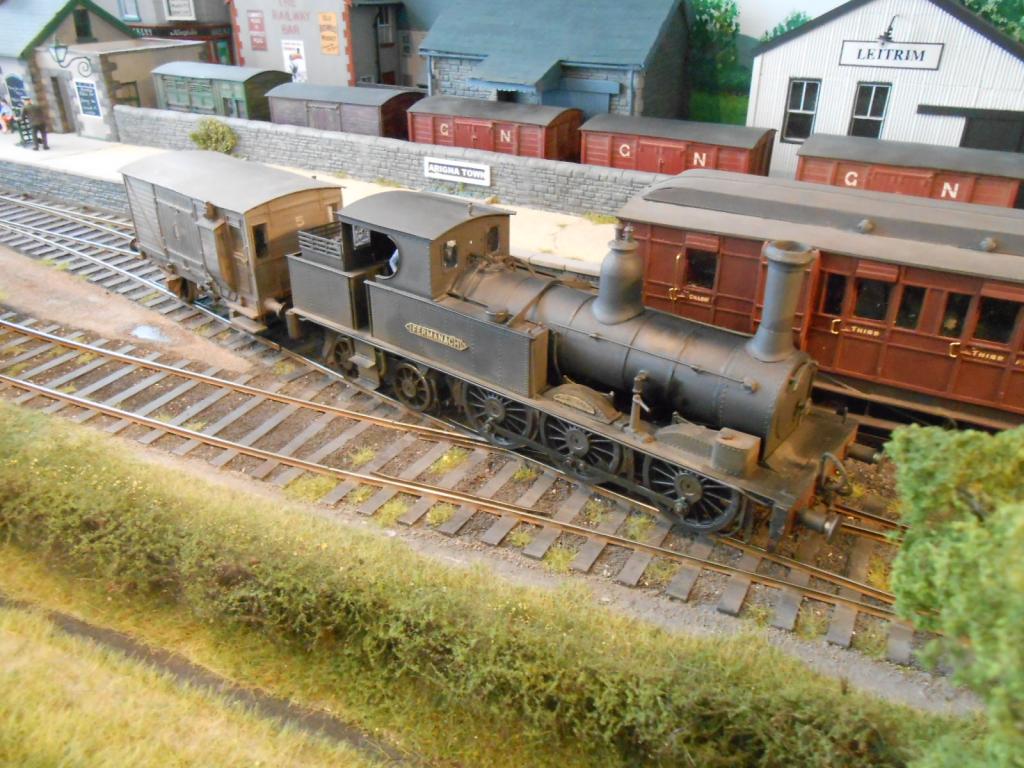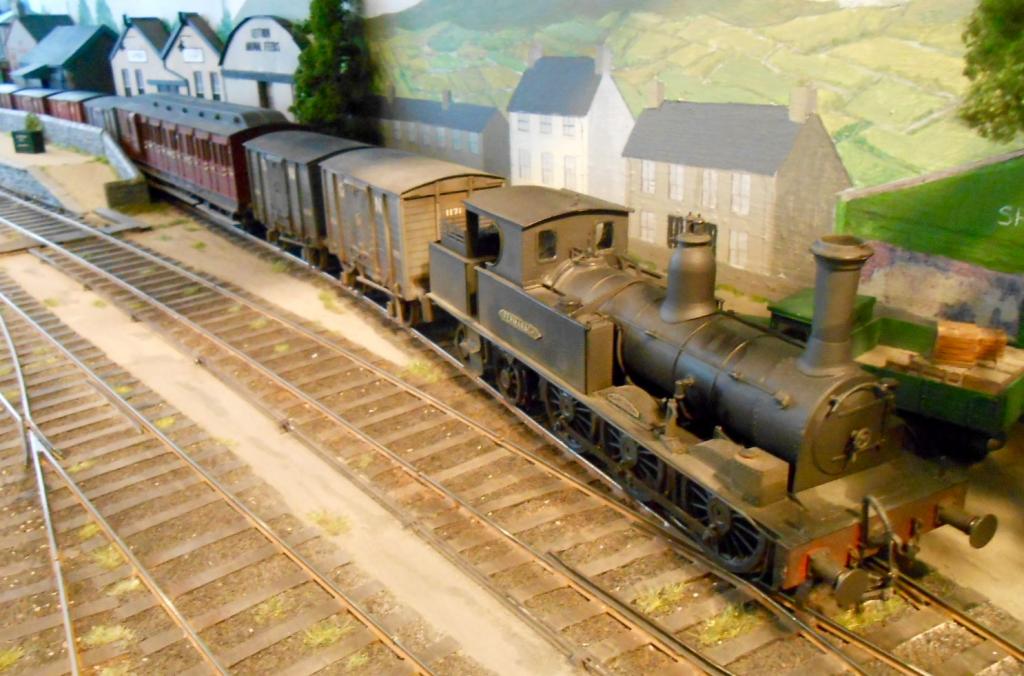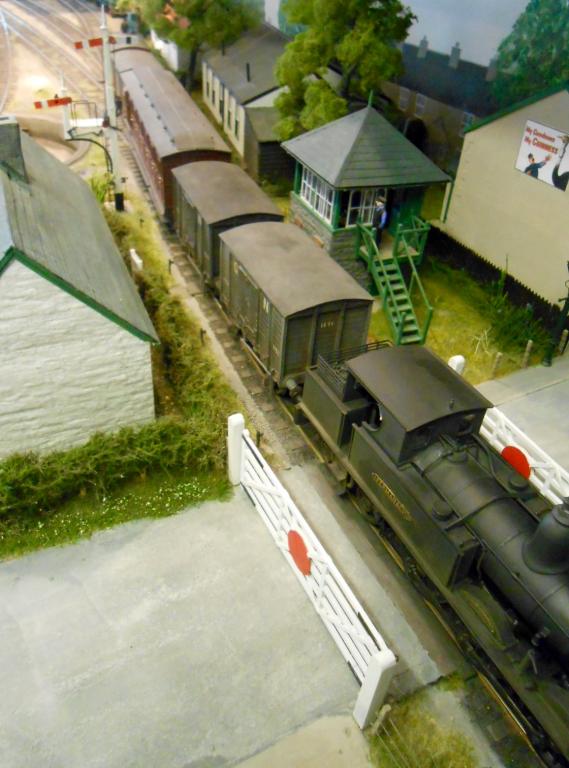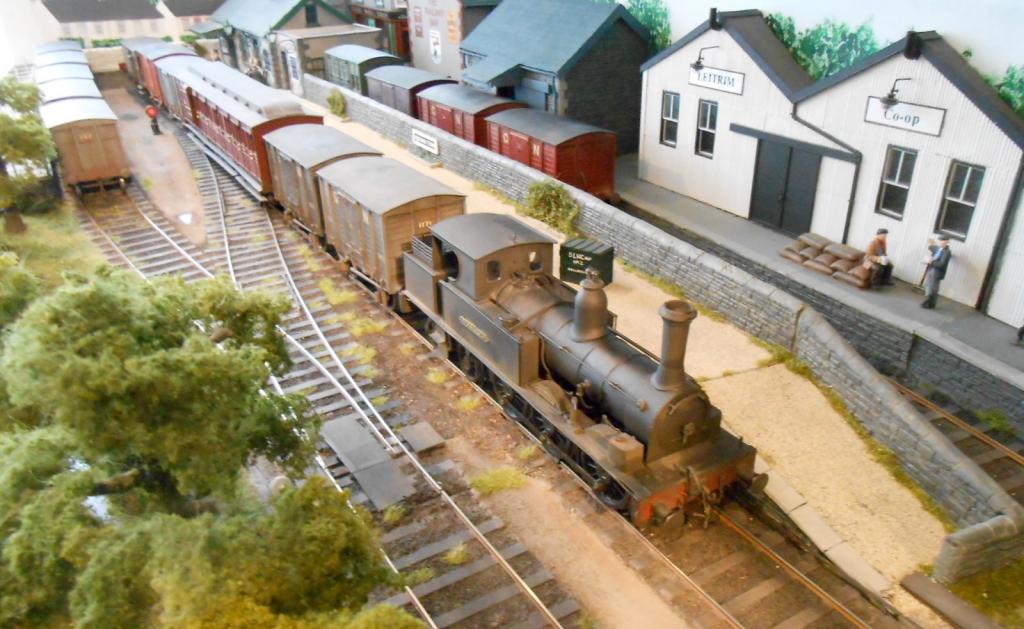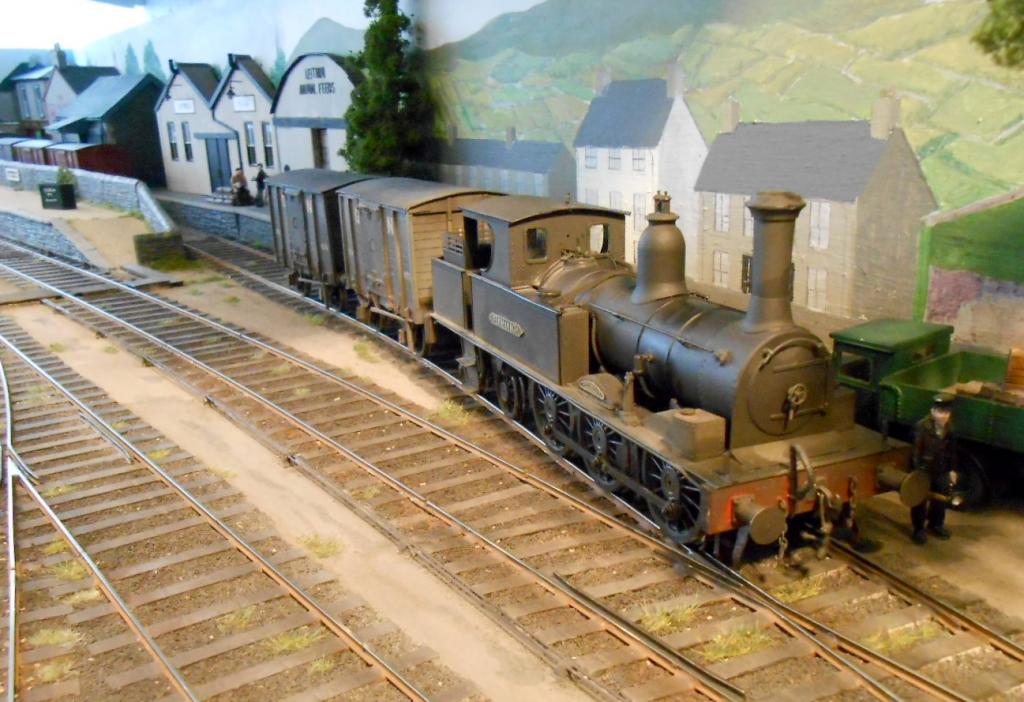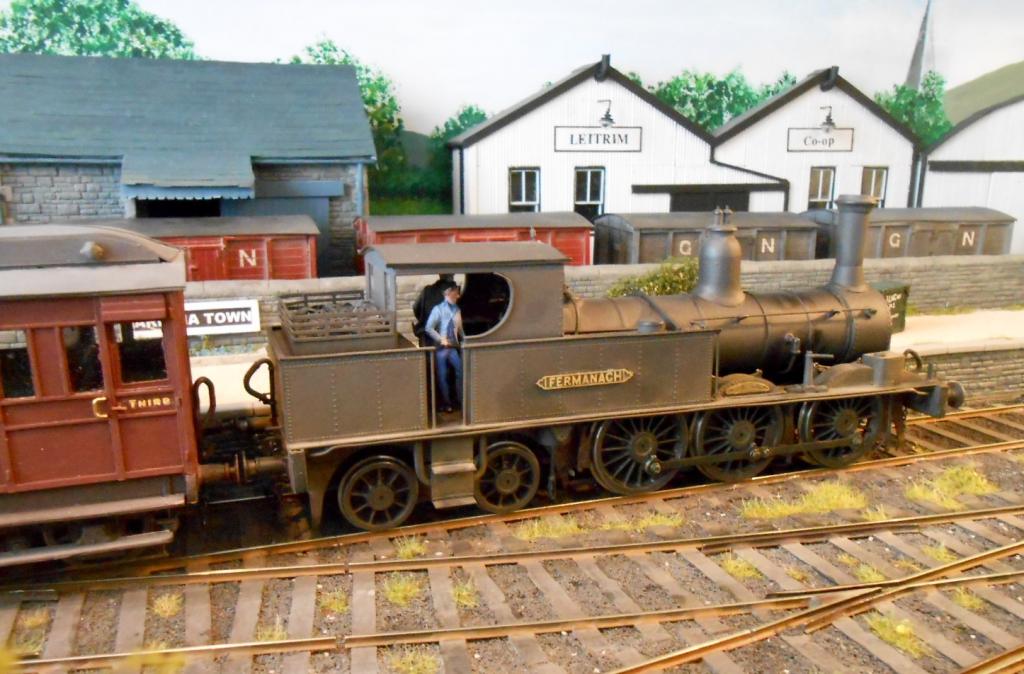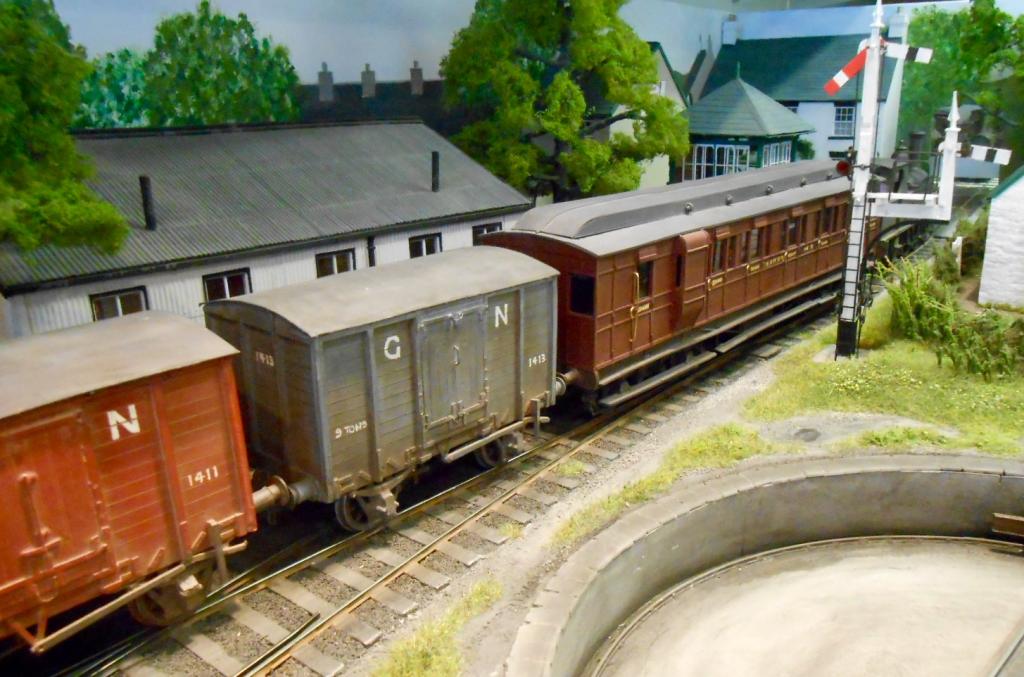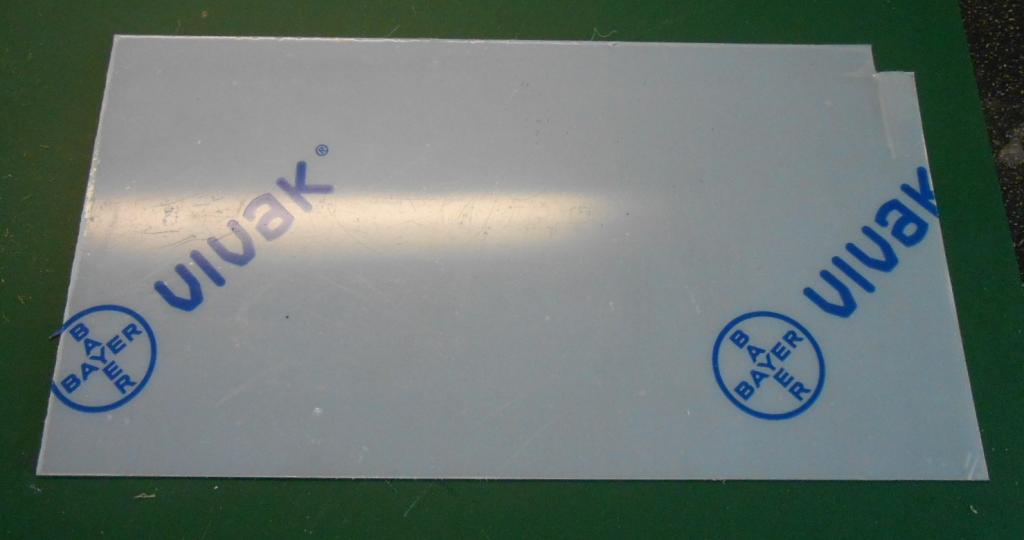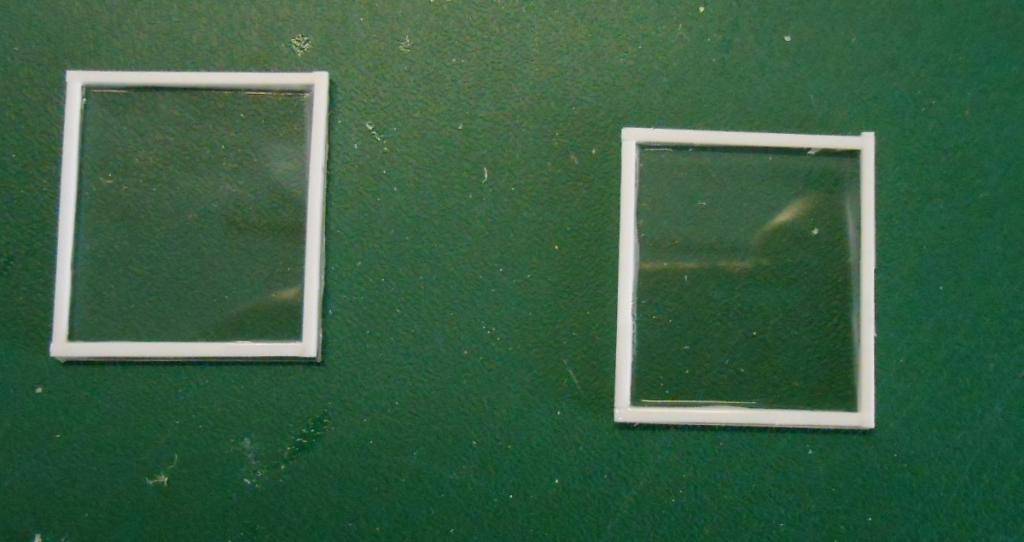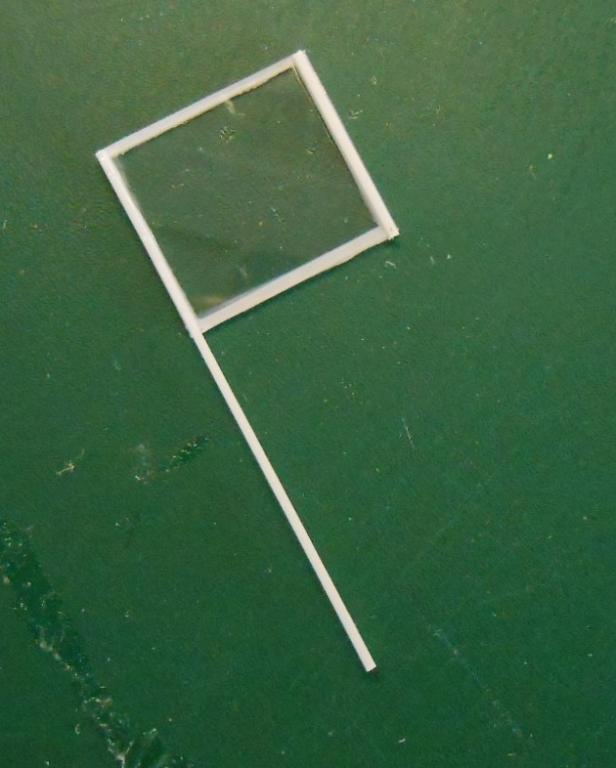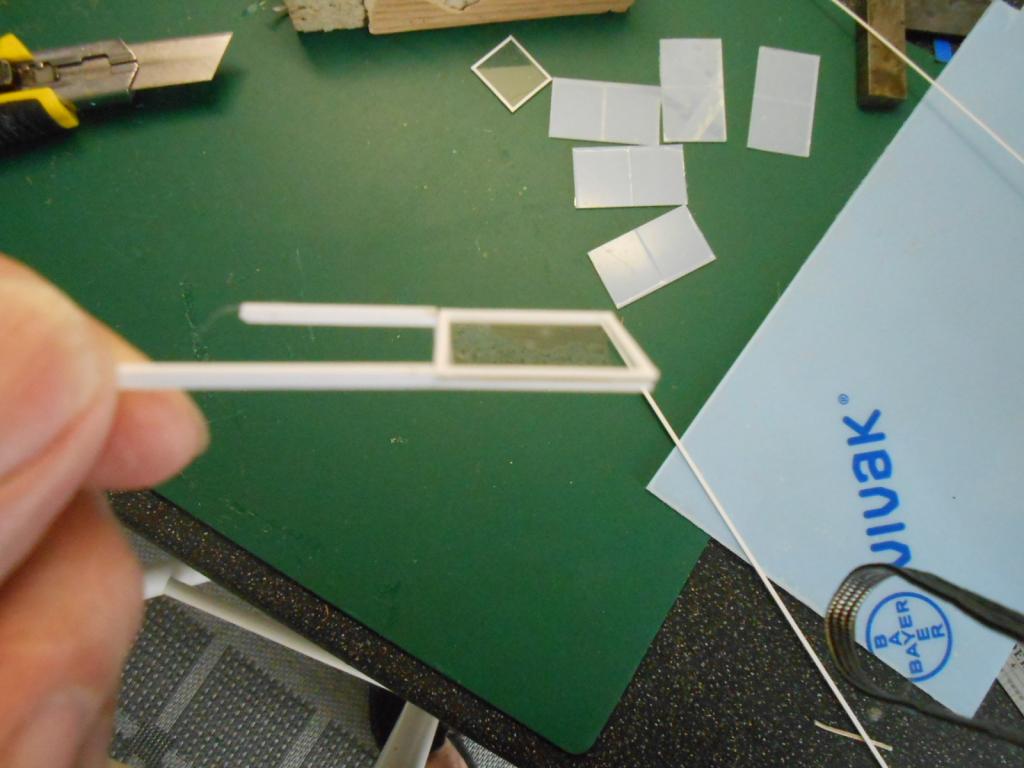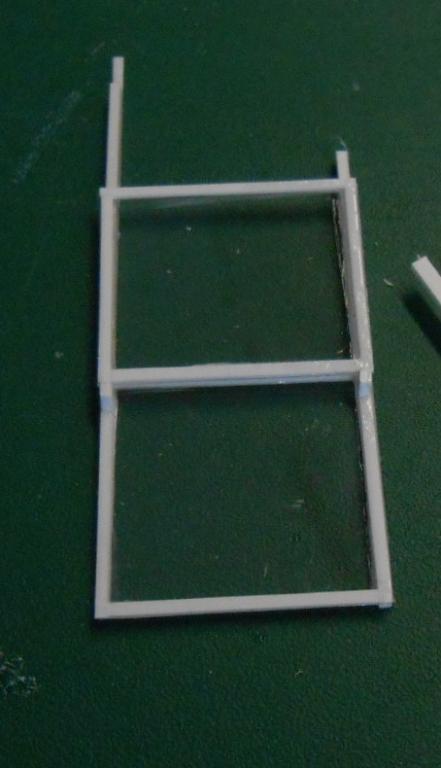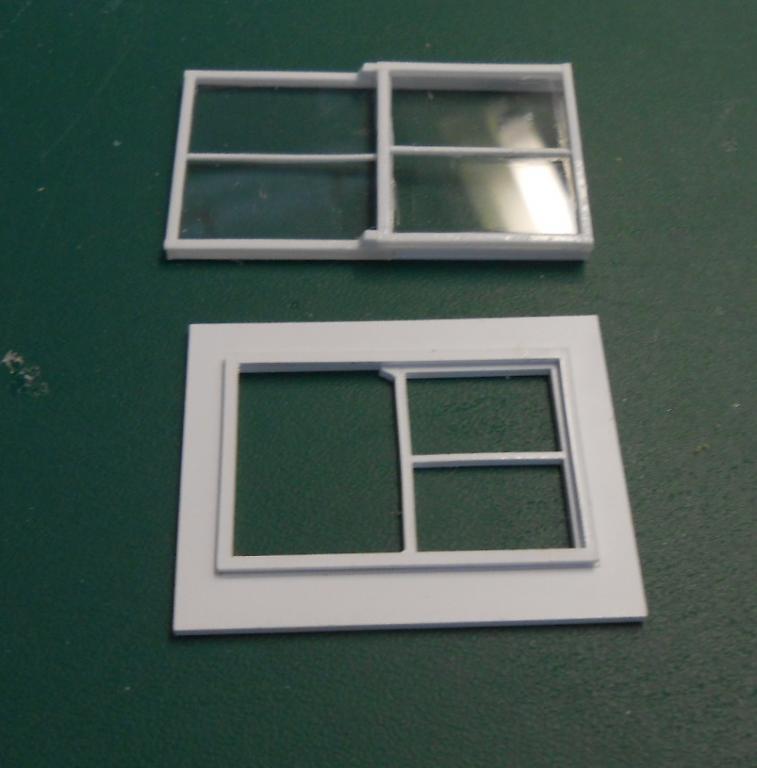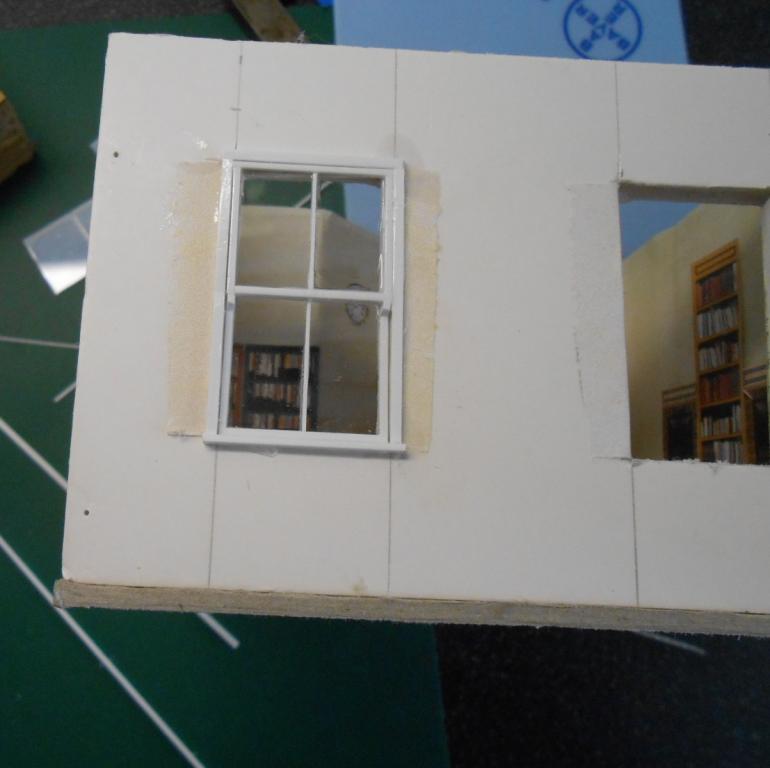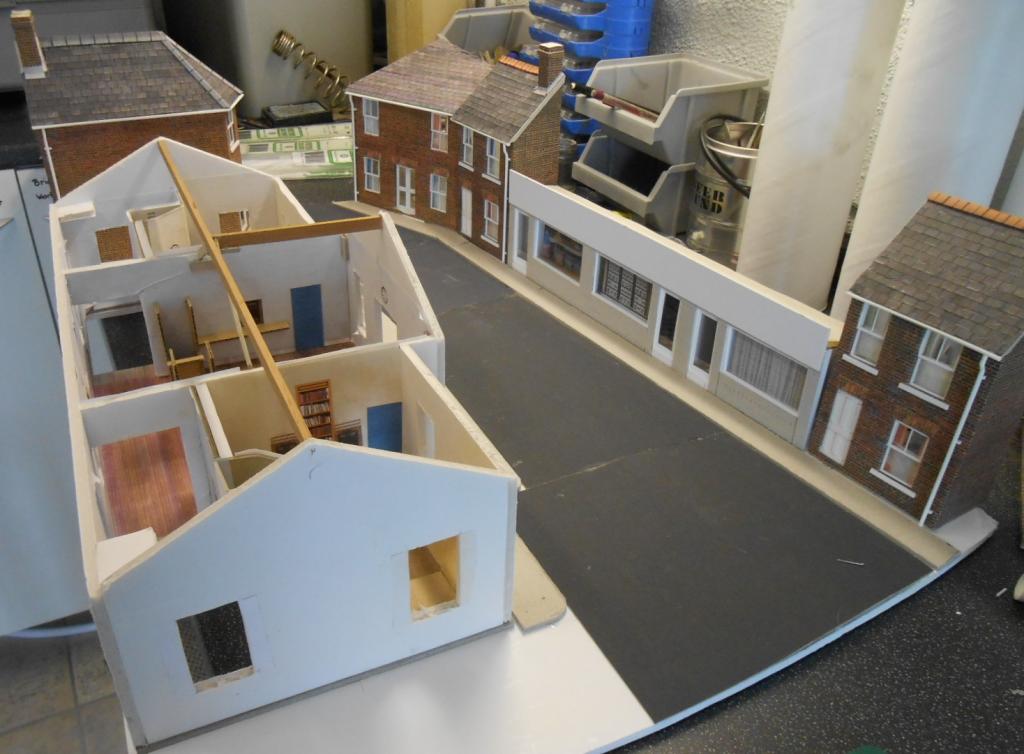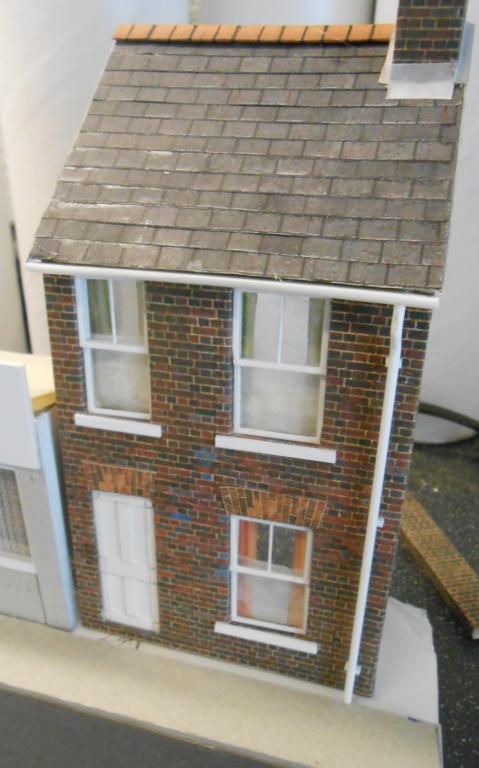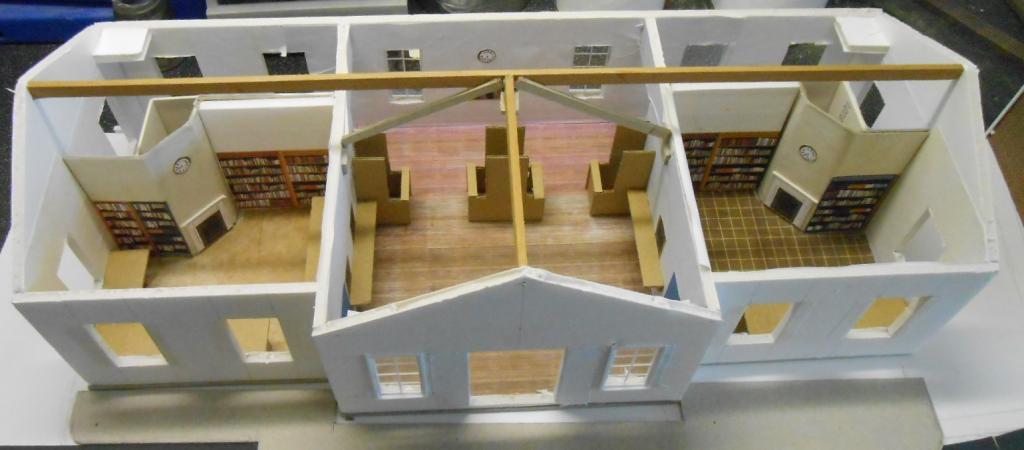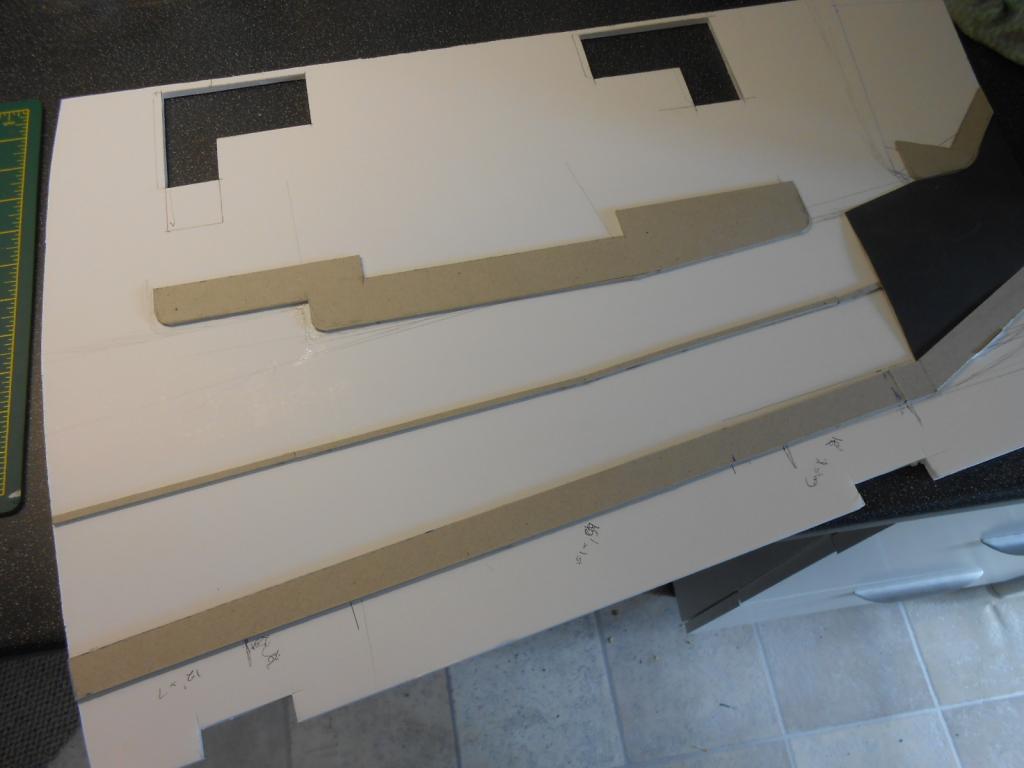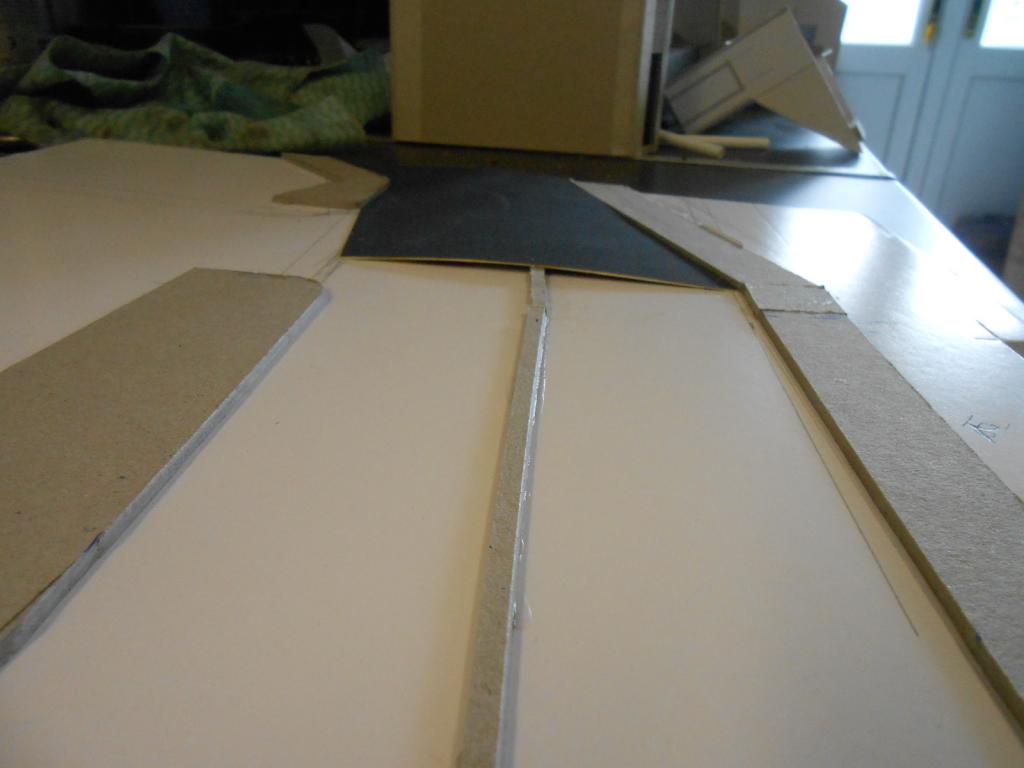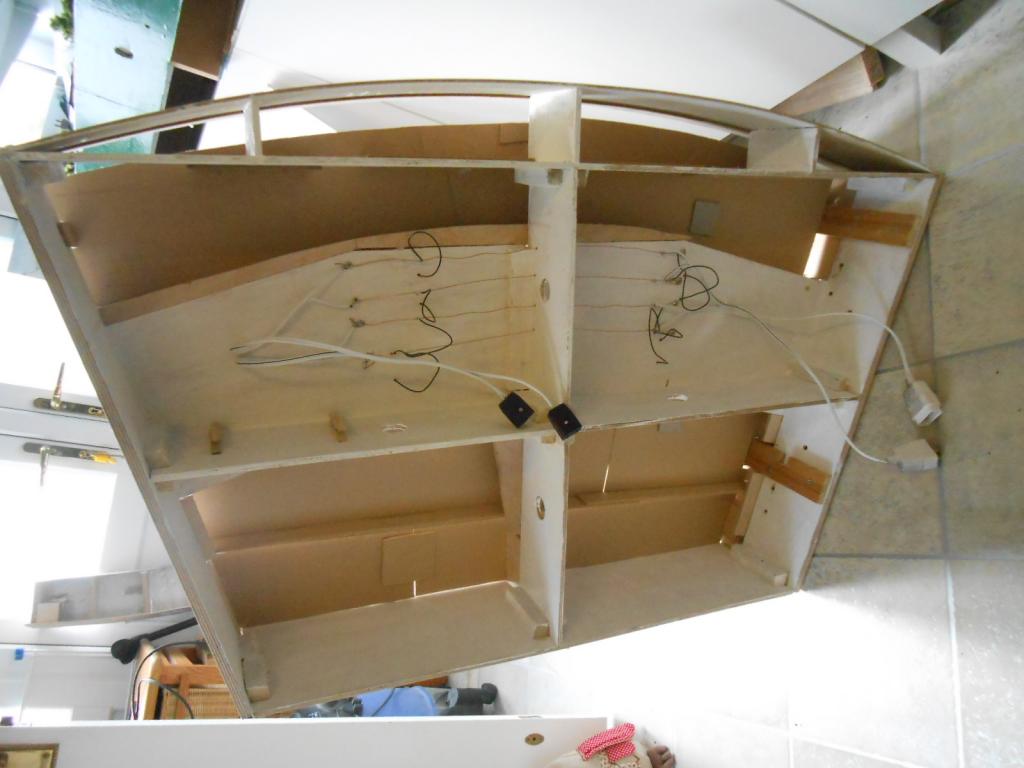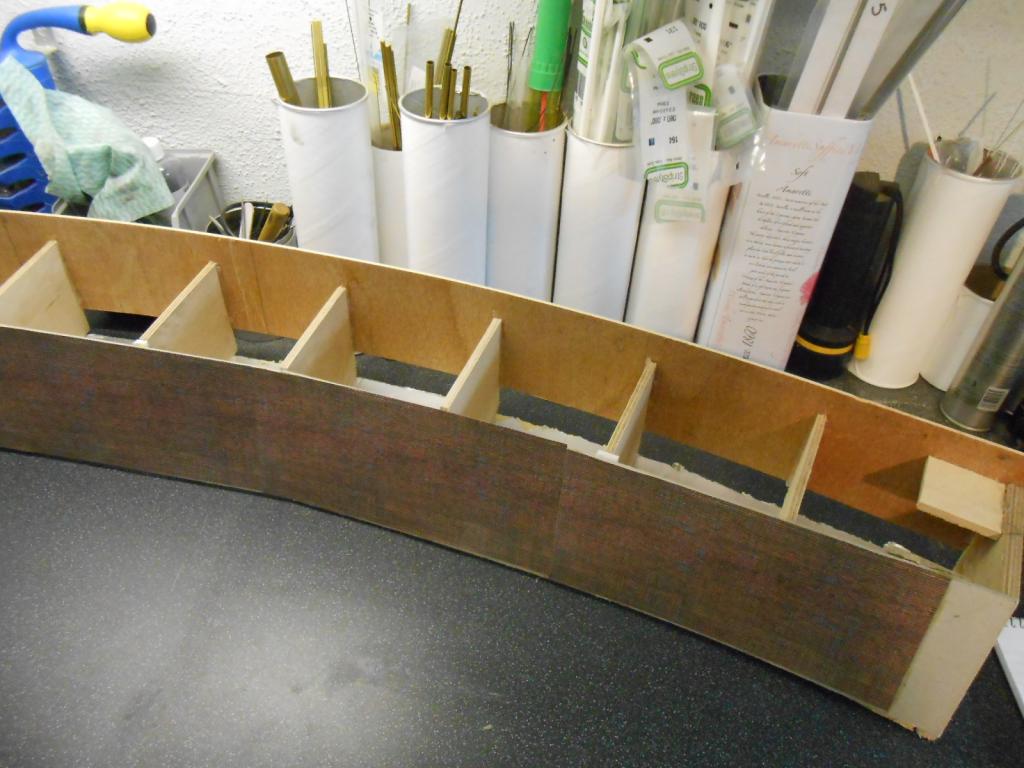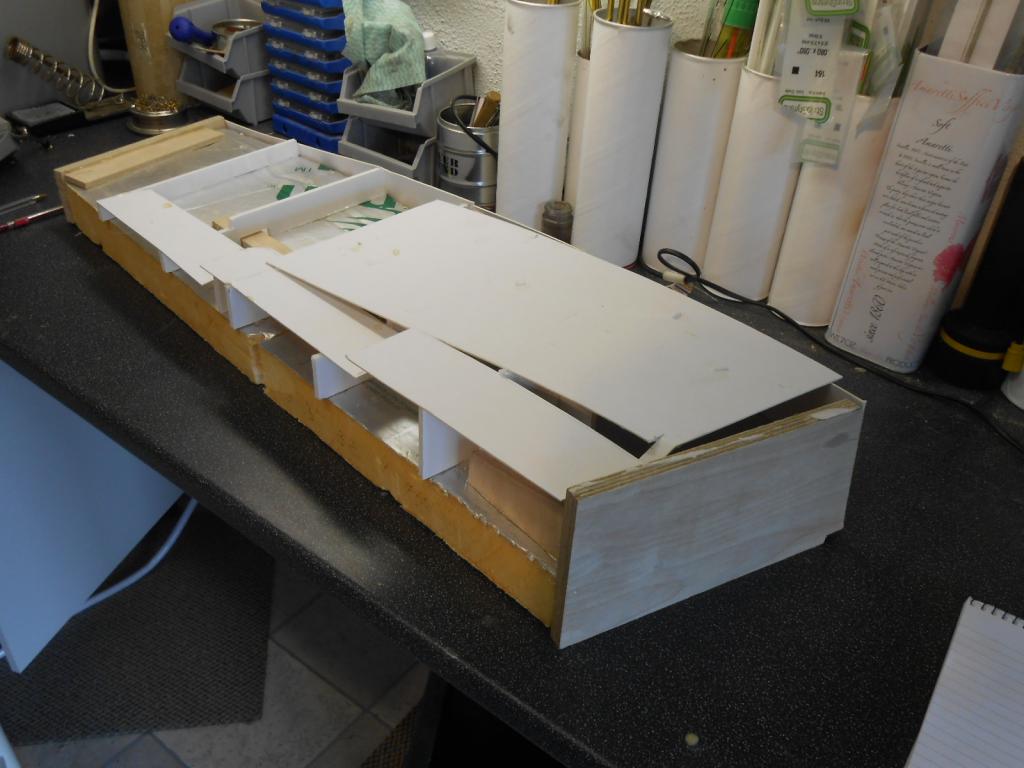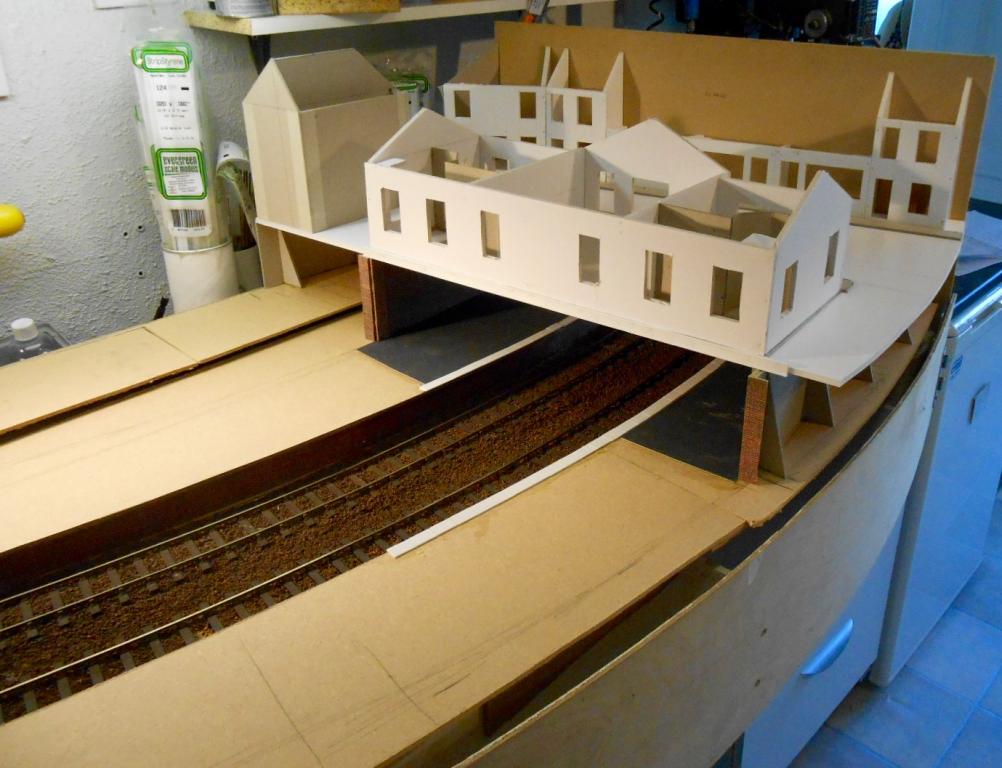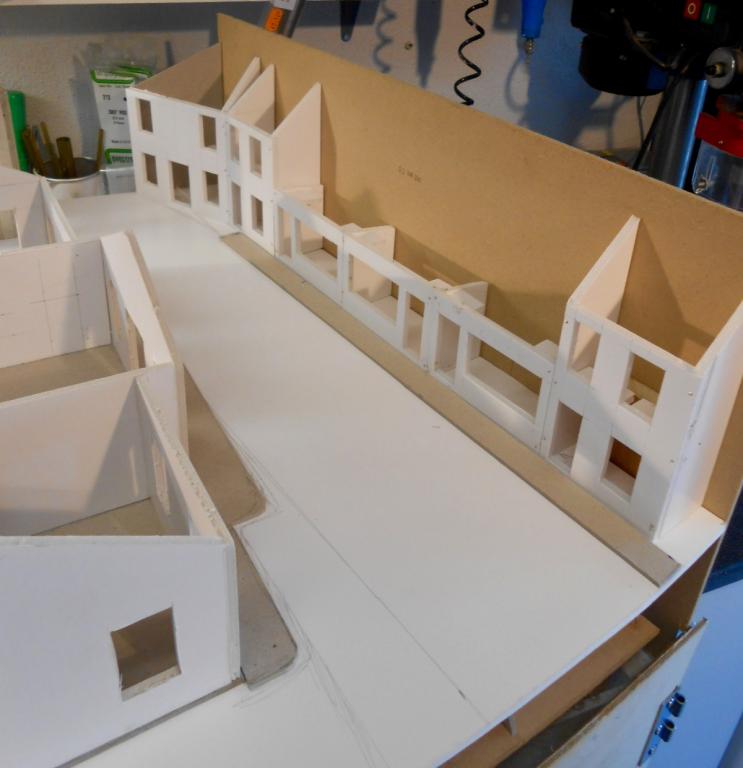
David Holman
Members-
Posts
4,359 -
Joined
-
Last visited
-
Days Won
117
Content Type
Profiles
Forums
Events
Gallery
Everything posted by David Holman
-
Ariana Town's fiddle yard has 7 tracks, six of which are now filled. The final track has long been reserved for Sir Henry, the SLNCR 'large tank', which I fell in love with courtesy of Neil Sprinks photo album of the line. Two things have put me off making a start, one the loco has to be a scratch build and with at least as many rivets as a small tank, is certainly no easy undertaking. Second, it was deciding on a train for it. I already have too many wagons, but didn't really want to add another freight train to the operating sequence. Looking through the Sprinks album once again gave me the idea of a short passenger train, made up of coach 10 or 11, plus a six wheeler and the parcels van I built last year. Alphagraphix do card kits of the coaches, so I've ordered a couple & finally decided to grasp the nettle on the loco. My CV now runs to well over 50 locos & though many are etched brass/nickel silver kits, I've only previous done two all metal scratch builds. Little and large, one is the Wantage Tramway well tank and the other a D16/3 [Claud Hamilton] 4-4-0. Plus, both were a while ago now, so it all added to the procrastination... However, the modelling season is upon us & creating a complete train seemed like a nice winter project - though it will probably take up autumn and spring as well. A starting point exists in that the Manchester Museum of Science & Industry holds a collection of Beyer Peacock drawings & I bought one a while ago and got as far as creating a basic outline drawing in 7mm scale. This was necessary because the BP one is a general arrangement [GA] drawing - a bit like a X-ray of the loco, showing much inside detail. Basic dimensions are also in the Sprinks history of the line, showing 4'8 16 spoke drivers and 3'0 bogie wheels. These are on order from Slaters, though there was an early issue in that the wheel spacing is 6'7+ 4'11. This means there is precious little space between the rear pair of drivers, so I've changed the spacing to 6'6+5'0 because there was every chance that the flags would be touching otherwise. Another problem is that there appears to be no source of coupling rods of this size, which is a shame, because rods are very time consuming to make and Premier Models do a very nice range of profile milled rods - but none that are anywhere near my needs. Also a pity, because I was tempted to build a sprung chassis, requiring jointed rods, but in the end chickened out and made a solid pair. These are very much the starting point for any loco chassis as by making the rods and them clamping them to the frames for drilling, there is a good chance that a smooth running loco will result. So far, have spent the last two days making the rods from 1.5mm brass strip, overlaid with a thin strip of 'fluted' brass. Nickel silver frames have been cut from 22swg & all in all this is not a quick process. Thin brass/nickel silver can be cut with strong scissors, but thicker stuck needs piercing saw, though I often cheat and use a slitting disc in the Dremel for longer cuts. A long list of castings/fittings is being prepared. I don't have a lathe, or indeed know how to use one, so am hoping there will be something suitable for the all important chimney & dome. At least I have a nice domed smokebox door in the spares box, otherwise a visit to the GOGuild Trade Show at Reading in December will help fill the shopping list. The photos show the loco, a section of the GA drawing and the start made with the rods, so watch this space
-
Arigna Town - this week's scenery
David Holman replied to David Holman's topic in Irish Model Layouts
A case of goods in/cattle out. Hazlewood is the train engine, usually with five vans of SLNCR/GNR/CIE origin. After the loco runs round [and visits the turntable], the vans go to the goods siding & Hazlewood picks up the cattle vans to make up the return train. As can be seen from the photos, this means the good siding is completely full & a certain amount of trial and error has led to a specific set of wagons in the sequence. One too many [or indeed, couple too long] and the rake fouls the main platform line. On the reverse working, the cattle train enters the loop line [a rare use of the third doll on the signal] so the cattle vans go back to the dock after the loco has run round. Most of the time it all works really well, though occasionally I get the wagon order wrong and we find that the goods siding is overflowing. A few rude words [and when no one is looking] a bit of crane shunting usually sorts it out, though some of my more eager operators will happily fall on the resulting Chinese puzzle and spend 20 mins or so sorting it out the proper way. The last couple of pictures show the yard at the end of the sequence, after which the fiddle yard needs rotating, so a new sequence can begin. I haven't included the railcar/railbus or excursion train, as these are simple 'out and back' movements which have been shown extensively elsewhere on the site. However, look out for a new chapter in my workbench section - there is still one spare track in the fiddle yard and I'm hoping my 'winter project' will fill that, eventually! -
Arigna Town - this week's scenery
David Holman replied to David Holman's topic in Irish Model Layouts
Been there, got the T shirt, Stephen - probably a whole drawer full by now. The most recent gremlin attack was at January's Orpington show, when a short on the points at the station throat effectively froze the whole layout. Given there are only 6 wires between baseboards 2 & 3, it was doubly frustrating. Took an hour to sort out & ended up cutting the wires to the two plug/sockets and hard soldering them. A lot easier to repair back on the workbench, instead of upside down under the layout! Thankfully, my other operator was able to chat to the public & it seems there was enough static interest on the layout to keep them amused - which is more than I was... Seems no matter how well you prepare, journeying to a show and unloading/setting up can still cause problems. The ones that annoy me are the 'built in' ones that the owner/operators of the layout haven't bothered to fix since the previous outing, or indeed at all. Not just the working bits either - saw a layout only this year that had clear footprints on the back scene! Like many things in life it can be a shame when we remember these more than the good bits, which out weigh the former many times over of course. -
Arigna Town - this week's scenery
David Holman replied to David Holman's topic in Irish Model Layouts
Thanks H - it is always nice to get something published and what is more you get a nice cheque for it too! While I'm here, might as well add the coal train pictures. This is the only time there are two trains on the layout. The theory is that 'Lark' [aka St Mologa] brings loaded coal wagons down from the mine & these are swapped with a stores train, brought up the 'mainline' by MGW E class 0-6-0T. The E arrives first, its short train comprising a carriage truck with a portable generator as a load, then an open wagon loaded with pit props, plus two more opens containing oil drums and drainage pipes. SLNCR brake van 6 brings up the rear. The E moves the train to the goods siding, then pushes the brake to the platform stop blocks & retires to the turntable siding, where it can take water from the tank. Lark then arrives with 5 loaded coal wagons. It runs round, picks up the stores wagons from the goods siding and then reverses this train on to the brake of the coal train. Once the latter is uncoupled\coupled, Lark can depart back up the mine branch. The E class can then come off the water tank and propel the loaded coal wagons back to the other brake, so it too can depart, this time for Sligo or wherever the fuel is needed. Perhaps one day, this will just be a short journey to the new power station being built on Lough Allen & eventually, it may even be diesel powered? At exhibitions, there is a reverse sequence to this, with Lark bringing an empty stores train down from the mine and the E class returning with coal empties. The coal loads [and the pit props] are removable, but at shows we rarely bother and so far, nobody has commented. Just goes to show that one can have too much detail, perhaps? See the upload has once again managed to put the photos in the wrong order. Hopefully folk can work out what the correct sequence should be. -
Arigna Town - this week's scenery
David Holman replied to David Holman's topic in Irish Model Layouts
Thanks JB. 20 odd years of exhibiting has gradually taught me that simple layouts can look effective, especially if there is enough scenic interest to occupy the viewers between trains. However, they can be quite demanding to operate properly & though we don't use head/tail lamps, most train movements are properly signalled and we run at realistic speeds. I feel it is important to have a brief pause once a train has stopped in the station, before setting back into the loop to run round. Putting signals back to danger is the usual trick. Happily, the track rarely causes problems, though operator error is another matter! Three link couplings are a pain, even in this scale, while screw links require the tongue to be bitten from time to time - though I'm sure people know what we are thinking... What is interesting [indeed disappointing] is that younger/inexperienced operators can have little understanding of how a railway is run. Not their fault, because shunting is so rarely seen on the real thing these days. I'm no expert, but remember one awful occasion with a previous layout. Left a couple of club members in charge while I went to lunch with the advice to 'just shunt the goods train'. Quickly realised this was not understood, so expanded with 'run train into loop, run round, move brake van to stop blocks and then swop wagons from train with those in the sidings'. Technical terms which fell on deaf ears. When I returned 20 mins later, the operator was moving wagons around BY HAND, with a crowd three deep looking on. I seem to remember I wasn't happy, not least reminding him that these folk had paid good money to see trains run properly. Sadly I don't think he'd ever done much more than run his own trains round in an oval. Some serious tuition took place over the rest of the day, and things did improve, but I still see poor operation all too often at shows - sometimes by folk who ought to know better. -
A mighty beast indeed...
-
Arigna Town - this week's scenery
David Holman replied to David Holman's topic in Irish Model Layouts
GG is correct, the layout's stock gets a photo feature with extended captions. However, little in the way of change scenic wise so, with stock needing checking prior to going to Worthing in a couple of weeks, thought it might be of interest to go through how the layout is operated at shows. We don't work to a timetable, but do operate a set sequence, in order to illustrate the types of trains which might have run on the branch, had it actually existed. Control is analogue, using a Gaugemaster handheld unit, while both points and signals are all wire in tube; couplings are three link and screw links. The underlying concept of the layout is that each train has a simple routine - enough to keep operation interesting, but [hopefully] not too taxing, so everything runs smoothly. First up is the mixed train, with Fermanagh, bogie brake third coach No 9, two vans and a brake. Shame it can't have more wagons, but this is all that will fit in the fiddle yard. On the layout, we can see that the cattle dock is full of vans waiting for the later goods train, while the siding to the goods shed has a range of vans, including a horse box and parcels van. The pictures show Fermanagh arriving & then it sets back the train, in order to run round. First though, it visits the turntable, then picks up the brake van and moves it to the stop blocks. The main shunt is the to pick up the rest of the train [coach included] and shunt into the goods siding to pick up two more vans. The vans/coach/vans sandwich then shunts back to the platform, where the coach and two new vans are attached to the brake van. The incoming vans can now be shunted into the goods siding and Fermanagh can then return to its train, couple up and be ready to depart. Next time, the coal & mine trains will feature. -
Arigna Town's locos and rolling stock feature in the October RM [just out]. Am mostly pleased with the pictures, though one I took of Lark shows the works plate isn't straight. seem to remember it was done in haste, when plates were only held on with Blutak. Come to think of it, they still are!
-
Dichotomy - a dual scale layout
David Holman replied to David Holman's topic in US / Canadian Railway Modelling
Gawdloveus IT, have only just looked at this thread and see it is 18 months since your post! Am guessing you have found the answer to your question by now, but just in case... Was amused to find that the CD that comes with a Tsunami sound chip runs to over 200 pages if printed out. No chance of that, of course [not with my printer ink, anyway], but the main point with tuning a steam loco's sound is to avoid the 'chuff' happening all the time. The regulator only stays open while the driver is moving away/accelerating [especially on a small layout] , so what I did was adjust the coasting & braking settings on the chip. Hence when operating the loco, i give it an initial burst of speed, then reduce the controller back to zero. Chuffing dies away, leaving just the hiss, clank, brake squeal etc. Takes a bit of practice in terms of judging where the loco will stop, but adds to the fun and you can always open the throttle again briefly if the loco is coming up short. The little layout is due an outing shortly at the village 'Crafts Day', so have treated myself to a small diesel switcher [also with sound], which I got second hand for just £60. Will take some pictures and give an update shortly -
Fine work Nelson & all the better with just scale couplings, though appreciate that may not be practical operationally...
-
Could be that the Cavan & Leitrim models were the bogie coaches produced by Branchlines, JB. I actually had a couple in the '90s. Fairly basic kits, they made up well enough & had the advantages of etches to cover the ornate balconies. Built mine for an English might have been called the High Weald Light Railway, which appeared in Railway Modeller a couple of times. Am now hoping the kit may still be available as a C&L diorama is very much on my list of future projects. If only I hadn't sold the originals!
-
Small dribble of saliva now coming from the corner of my mouth. Add in a C and a G and Arigna Town will definitely be having a diesel phase!
-
Thanks Eoin. Have been using Humbrol Liquid Poly for many years. A bit fierce for some tasks [and smelly], but certainly does the job re microstrip and perspex. Check out Peter Smith's latest book on using printed papers. He's the man behind Kirtley Buildings. Called Using Printed Papers in Railway Modelling; ISBN 9781505358476. Got mine from Amazon & whilst I don't agree with everything in there, it contains much of value & interest.
-
Realise most of you work in 4mm scale, but in case anyone is interested, here is how I make my own windows in 7mm scale & there may be aspects that work in both scales. First up the glazing material. I've long used perspex, rather than clear plasticard. It does not cloud when it comes into contact with solvent. The station sash windows are approx 6' x 3'6, so i first cut a strip of perspex 3'6 wide and make it off into 6'1 lengths, which are then further divided into 3' and 3'1 [using my scale ruler] to allow for the overlap. Cutting the perspex produces a significant 'cusp', so this then needs paring off with a craft knife. The pretty much ends any measuring, for the frames [40x20 thou microstrip] are all cut in situ. Once an outer frame is on each pane, the one that is to be the lower one is then turned over & two extended vertical sides are added. 40x60 strip is then stuck to this, to create upper frames & the top pane is then added to this, with a slight overlap. Two small pieces of 40x60 are added to create the stop blocks & then 20x20 thou strip is the final touch to make the central glaring bars. Total time - about 10 mins or so, once I get my eye in, though the first of a new batch always takes a little longer. The completed window is then a push fit in the aperture of the building and [because it is a timber framed] an outer frame of 40x60 microstrip then glued round the end with UHU. Finally, solvent is run into the join between this & the window frame to fix it in place. As I mentioned before, the cost of each window frame is about 80p/one euro. That is based on a pack of microstrip now running at £4, for 10 pieces and you use two of them. A York models version is show alongside for comparison. These cost £1.75 each, but construction time is nil. However, you don't get the proper split of a sash window & therefore cannot readily show them as open - as seen in the photo of the station building on Arigna Town. Other photos show the various stages [sorry they are not in the right order - why does that happen?], plus how the windows are then mounted in the model.
-
The Chatham Club's North Circular layout is going to need scores of buildings for its urban setting, so I'm trying to ensure that we can build to a consistent standard. Step one of this is to use building papers, rather than embossed sheet. The ones we are using are from Model Scene. You pay to download various files & can the print off as many copies as you like, for as long as you like. Their dark brown brick has been the choice for the houses around the main station, but the station building is deemed to be timber, so has cladding made from cereal packet card. Big windows mean that a fair amount of the inside can be seen, so further Model Scene files have been printed and used for walls & flooring, plus things like pictures, book cases, clocks etc. Also tried out CGtextures, a Dutch website which has a wealth of stuff including doors, floors, windows shops & much besides. Well worth a look. At the moment, am doing my usual scratch built window frames - I can do a sash window in about 15 minutes. However, the cost of microstrip means each one can be anything up to a euro [75p], so have ordered some ready made windows from York Modelmaking. These work out at about £1.75 [2 euro] per window, so it is clearly going to cost the club funds a fair bit. Nevertheless, think it will be worthwhile as these features will bring a good level of consistency to our models, no matter who builds them.
-
Two classic buildings. Very nice indeed. That cutting mat has led a hard life!
-
[ATTACH=CONFIG]19151 Those of you expecting something risqué, will no doubt already be disappointed by the picture, but these little jobbies are saving me 20 minutes of set up/knock down time at exhibitions. Mentioned them in my blog, but thought a photo might be useful. Available from your local DIY superstore, they replace M6 bolt and wing nut on my light posts, pelmets etc. Not very applicable for home layouts, where everything is nailed down, but a real boon on exhibition layouts. Will use them on the North Circular layout too - including slotting all the back scenes in place. 16 back scenes would need 32 bolts = around 15 minutes to set up. with flush mounts, the whole lot can be done in seconds.
-
13-14th June at Mid Kent Leisure Centre, Gillingham. 30 000 square feet of halls & nearly 100 stands, 30 of which are layouts, including the splendid 3mmFS Ballyconnel Road - worth the entrance fee on its own. Chatham Club's developing 0 gauge layout there too. By all means come and say hello.
-
Midland Great Western Railway carriage livery and Broadstone photographs.
David Holman replied to Ian's topic in General Chat
7mm scale definitely worth considering. Ariana Town is just 3.6m long on the scenic section. Track not a problem, with C&L parts or copper clad. Alphagraphix catalogue contains several etched brass kits of the E class 0-6-0T and G2 2-4-0, plus etched brass and card kits of the 6 wheel coaches. Not difficult and VERY addictive! -
Nice to see this has created some interest, though in this Workbench thread, will aim to concentrate purely on building techniques, though may well post a few more photos etc on the 'English' section of the website. However, just to answer a couple of questions, at the moment, we have no plans to add extra rails, because the inspiration for the project is the Tottenham & Hampstead line. This was never electrified [and does still exist], but carried pretty much all BR regional locos, with the exception of the GWR outside cylinder locos, which were just too wide. Hence we have licence for all the early BR diesels, plus LMS suburban and freight type, all the LNER Pacifics ran through at some time or other, plus their were plenty of SR types on transfers too. Have attached a couple of pictures of the baseboards. Built of 6mm birch ply, they are very stable, very strong, but also very light. The only fixed surface is the track base [also 6mm ply]. The scenery is using the 'jigsaw' concept, with removable sub sections for an area of deep cutting. These use insulating foam board as their base. Being curved, the boards need to be kept fairly thin for economic transport [this is designed as an exhibition layout], so several scenic sections have been made removable & easy to slot in place once the main parts are erected. Hopefully the photos show the idea. There will be a lot of brick work on the layout, so we are standardising on brick papers for this, which I think can be surprisingly effective. There is a new book on the subject by Peter Smith [of Kirtley Models], which is full of ideas and well worth reading. The other photos show a bit more of the station area, in particular how I've started the road over bridge. The surface is properly cambered and uses 400 grit wet and dry paper to replicate tarmac.
-
So, suitably replete - farctate even - what's in this new project of interest generally? Each baseboard is one twelfth of the original circle. This will include two 'bitsa' stations [as coined by Iain Rice], now separated by the storage loops on one side of the full oval. A 'bitsa' station is what it says on the tin - just a section, rather than the full thing. In 0 gauge, even a platform capable of holding a six coach train can be well over 3m long and, when you think about it, not much in the way of action happens at platforms. Trains stop & depart & that is about it. The real action happens in the goods yards [or did in the past], so that is what the main scenic section of the layout concentrates on, together with scenic bits to join them up. The pictures show one of the stations [no name yet - need to find a suitable London street]. The main building is on an over bridge, flanked by brick built houses & with single storey, timber commercial premises opposite. The station is timber too, to reduce the weight on the bridge girders. The design is fairly free lance, though I confess to some GNRI influences, with access to the platforms being via staircases. Rather than model these in full, going down, externally, to the platforms, they copy the design of Chatham's station in that they reach the platforms under the road bridge - which helps reduce the amount of detail modelling required. Stairs ain't easy things to model. The building is in skeleton form thus far, being just a frame of 5mm foam board. This has decent thickness, without adding much weight. It will be clad in lapboard and feature a full interior, so I'll try to report on its progress. Likewise the buildings around it. The whole scene sits on a large sheet of foam board, which at the moment is not fixed down, so I can work on it, away from the baseboard. The double track you can see is C&L flexi, enhanced a little by super-elevation. this was done by packing up the outer edges by 3mm with card, the ballasted on top. Subtle, but very effective, especially when trains pass one another. Ballast is from Greenscenes. It is crushed walnut shell, I believe & though effective in appearance [especially when toned down/weathered], it doesn't always take well to the standard PVA/water mix and we have had to patch up several areas - with some still to do. Platform surfaces are 400 gritty 'wet and dry' paper, with plasticard coping slabs, while the platform walls are all brick paper, of the sort you download from the Web and print yourself. The next jobs will be to create the stairs down to the platforms & add some supporting pillars. Watch this space...
-
There is unlikely to be much re the Irish scene for a while - so my activities are turning towards the Chatham Club's 0 gauge project, for which I am 'gaffer' for my sins. This is BR 1940-60s, so hardly applicable for this forum, however, there are aspects of construction which may be of interest. I won't bore you with the full details, suffice to say that it is called 'North Circular', aiming to depict a North London avoiding line, which hosted pretty much any of the Big Four's stock & therefore ideal as a Club project. The Circular bit comes from the fact that it started as a 4m diameter circle, but is gradually being extended into what will become a 10m x 4 m oval. Small it ain't! We have got the basics completed, with me actually using some ancient O level geometry and algebra to calculate the dimensions of the 12 baseboards which make the circle. These worked out so well that, even when we added 2.4m straight sections, everything still lined up. The boards are good quality 6mm ply, built from a jig we made to ensure all were pretty much identical. What will come next [sunday dinner is nearly on the table!] will be some of the innovative techniques we are adopting. So back shortly!
-
As the saying goes - 'quality always sells!'
-
Couldn't agree more Eoin. Can be just as satisfying as finishing a new kit or scratch build. Not sure why, maybe it just comes from making a older model work again - especially if you can make it better than it was before. Once managed to drop an 04 diesel shunter. A white metal Vulcan kit, it simply broke back down into its major components. Restoring it no problem but the fun came from adding extra detail and doing a better paint job.
-
The Official Irish 'Might Have Beens' Thread
David Holman replied to minister_for_hardship's topic in General Chat
Just been re-reading E M Patterson's history of the Clogher Valley Railway, where there is a section on extensions - including the fabled Ulster & Connaught. Seems both the Clogher and Cavan & Leitrim were keen to link up, with the former also interested in extending eastwards to the Bessbrook & Newry tramway, thereby providing a direct link to the coast for Arigna coal. The GN branch to Keady & the south eventually scuppered the coastal link, though they did build a tunnel to enable the 3' gauge line to cross beneath it. Still exists too! Hence, even if the U&C extension to Galway and Clifton had not produced a trans Irish narrow gauge 'mainline' [over 230 miles long!], a C&L/CV/B&N link would have produced the scenario of the first two's engines & rail cars sharing tracks and working with each other's stock. 'Tis a basis for a 7mmNG project I've often pondered - not least because of the variety of modelling it could offer. So far, cannot decide if it would be best in 21mm gauge/7mm scale, or 32mm gauge/10mm[ish] scale. One day...
.png.c363cdf5c3fb7955cd92a55eb6dbbae0.png)

